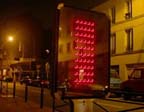June 08, 2007
glich-gen by DreamAddictive lab
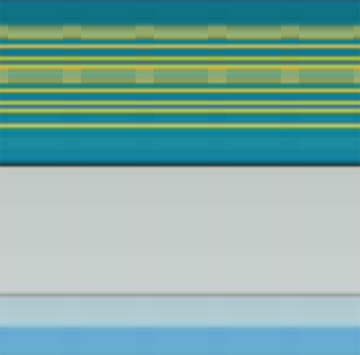
glich-gen by DreamAddictive lab :: Glitch is the digital deconstruction of an image that suffers a rupture in its source code, this rupture is known as a system error. Glich-gen uses a series of errors processed through a source code in actionscript 2 in order to generate computer animations based on image errors.
Posted by jo at 11:19 AM | Comments (0)
May 11, 2007
Heavy Opera: An Audio Tour to Awaken Londoners to
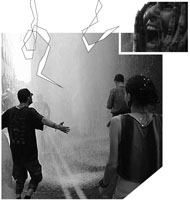
The Impact of Financial Systems on Climate Change
John Jordan and James Marriott’s operatic audio tour set in London’s Square Mile is intended to awaken city workers to the impact of financial systems on climate change. But not only does And While London Burns misgauge how much the suits already know, its hysterical tone also harmonises too easily with the coming new eco-order.
A fountain of water from the river Walbrook shoots up above my head, drums are pounding, a sound system’s bass rumbles. I hear cheers but I can also hear the clatter of police shields and batons around the corner. Seven years after London’s Carnival Against Capital, when protesters outside the LIFFE exchange broke a water mains sending a thirty-foot jet of water into the air, I am walking just a half a mile north of the same spot. Now I can hear the Thames rushing up the valley the Walbrook follows, bursting its banks, laying waste to the tall glass-fronted buildings as some of the most expensive real estate in London collapses around me. I’m swept up in a sonically induced fantasy driven by the tracks on my MP3player. I am taking part in And While London Burns, an operatic guided walk written by John Jordan and James Marriott, set to music by Isa Suarez and produced by the cross-disciplinary art and education group Platform.
John Jordan has played a role in both these participatory dramas, firstly as a member of Reclaim the Streets – one of the anti-capitalist groups that coordinated the Carnival Against Capital in June 1999. This time around as an artist commissioned by Platform – an interdisciplinary arts, campaigning and research group committed to longer term, less partisan approaches to transforming the activities of the financial institutions and corporations with head offices in the Square Mile. The walk is an attempt to dramatise the research Platform has conducted into climate change. James Marriott, its co-founder, explains:" from Heavy Opera by Anthony Iles, It's Not Easy Being Green, MUTE VOL 2 #5.
Posted by jo at 01:36 PM | Comments (0)
May 10, 2007
Synk
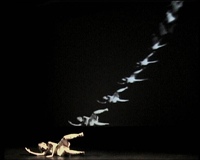
Real-time Processing
Synk is an experimental dance / video / audio piece where video and audio samples and recycles the movements of the dancer on stage, creating rich layers of images and sound. The performance deals with transformation of time ; distortion, displacement, delay, layering and buffering. The idea of Synk is that no prerecorded video or audio will be used, only material sampled during the performance are presented, to investigate live as raw material, and to impose a structure on a live situation to allow unpredictable results within that frame structure. Synk was made in 2002 and performed in a split-evening with the video ensemble 242.Pilots.
On Friday May 4th, (HC Gilje) performed Synk with Kreutzerkompani and Justin Bennett. More images from Synk (click on the small images).
Posted by jo at 02:32 PM | Comments (0)
February 28, 2007
MENDI + KEITH OBADIKE LAUNCH

Big House / Disclosure
BIG HOUSE / DISCLOSURE a 200-hour long house song with the voices of Chicago-area Citizens :: WHEN: March 1st- 8th :: WHERE: Northwestern Univ. Campus – Kresge Hall and online :: CONTACTS: office[at]blacknetart.com (blacknetart.com) & w-leopold[at]northwestern.edu, 847-491-4890 (Northwestern Office of University Relations)
Big House / Disclosure was constructed using audio interviews conducted by Northwestern University students with Chicago-area citizens about slavery and the city’s slavery era ordinance. Mixing these interviews with elements of Chicago house music, the artists created a multi-channel sound installation. The project includes 200 video clips of live art and musical performances viewable from the website. Musical events in the sound installation are triggered by custom-designed software tracking the real-time rise and fall stock prices of several corporations that have admitted to profiting from slavery.
Keith Obadike received a BA in Visual Art from North Carolina Central University and an MFA in Sound Design from Yale University. Mendi Obadike received a BA in English from Spelman College and a Ph.D. in Literature from Duke University. They have received a Rockefeller New Media Art Fellowship and commissions from the Whitney Museum of American Art, Whitechapel Gallery of London, Electronic Arts Intermix, and The New York African Film Festival. Their Internet opera, The Sour Thunder, was commissioned by Yale University, broadcast in its’ entirety in (104.5 fm) Berlin, and released by Bridge Records in 2004. In 2005 they launched Four Electric Ghosts, an opera produced by Toni Morrison’s Atelier at Princeton University, and in 2006 they performed a live sound art transmission from the Amory Art Show in New York commissioned by the Franklin Furnace. Big House / Disclosure has been generously supported by a Pick-Laudati Award from Northwestern University.
Posted by jo at 08:47 AM | Comments (0)
February 13, 2007
Audio Kinematics
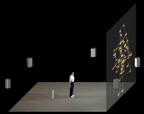
Virtual Audio Sculpture
Audio Kinematics, by Jost Muxfeldt, works with the idea of kinematic relations on the level of sound: a virtual audio sculpture. It utilizes the spatial relations and proportions of a mechanical structure to determine various parameters of a sound composition, and creates a kind of virtual kinetic sound sculpture.
MobileThe motions in the current realization are based on the principle of a mobile. This principle is base on a binary tree structure combined with circular motions. Since the motions of the individual nodes are always circular, they can over time be described with a series of sine waves added to each other . The motion of one node is thus described by the amplitude modulation of the sine wave of the parent node. Thus the motion is closely related to one of the most basic principles of audio synthesis.
The entire structure allows for a total sound experience in which the progression over time is determined on the one hand by the choice of the actual sound components, and on the other hand by the distance and motion of these components in relation to the listener. The listener becomes the center of an sound environment whose shape and timbre changes over time by means of its specific spatial mechanics.The motion is simultaneously projected on a screen so that the listener can follow the mechanics of the sound visually as well. [via]
Posted by jo at 03:31 PM | Comments (0)
January 30, 2007
The Burning Question
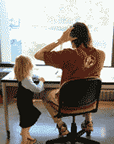
Gallery as Radio Station
The Burning Question, by Abinadi Meza, is a participatory installation and internet radio broadcast. This project consists of customized computers, large color posters, and pamphlets examining Intellectual Property and copyright. Multiple computers are loaded with hundreds of works contributed by composers, musicians, and sound artists from around the world. Visitors are offered blank CD's and invited to freely burn copyleft music; as they make playlists, they collectively generate an Internet radio broadcast that streams 24 hours a day from the gallery for the duration of the exhibit. The gallery becomes an impromptu radio station and visitors become DJ's. [via Rhizome]
Posted by jo at 02:39 PM | Comments (0)
January 24, 2007
Joe Winter
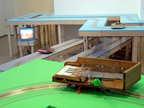
Fantasie no. 1 for Mobile Pianos
Fantasie no. 1 for Mobile Pianos is a kinetic sound and video installation. Five modified toy pianos circulate the gallery on five elevated wooden tracks. Each piano is equipped with small speakers to play amplified sounds picked up from conductive tape on the tracks. Each piano also contains small motors which intermittently spin to strike the toy pianos' tone bars, adding acoustic elements to the overall soundtrack of the work.
The installation also features five video monitors, which display images of five different real landscapes to compliment the abstract landscape of the wooden tracks. As the pianos begin to move around the gallery, these video landscapes become populated by a seemingly infinite stream of mobile pianos.

Distributed Performance
Distributed Performance takes place in multiple sites throughout a single building. Each site, or 'node,' is comprised of installed speakers, wire, various amplifiers, microphones, and a computer. All nodes are interlinked, both by audio cable and via ethernet. Each computer features the same display: an abstracted map of the space and the nodes within it, through which audio materials flow. When visual representations of audio flow within the spatial boundaries of a particular node, it is sonified there. The performer's presense at a particular node will serve to attract audio material to that location and to slowly organize it into rhythmic structures. Simultaneously, the programming may usurp the performer's control and direct the flow of materials elsewhere. The display may then serve as a map--both to the performer and the audience--to direct the flow of the performance from node to node. More >>
Posted by jo at 03:57 PM | Comments (0)
January 11, 2007
Ambient Addition
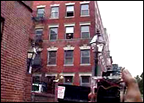
Music from Surrounding Noises
"As human civilization devises ever more powerful machines, living among them may become more and more difficult. People find themselves surrounded by incidentally created sounds and noises which are out of synch with their momentary needs. In order to avoid discordant noises they tend to use music reproducing devices with sound canceling headphones, isolating themselves from noise but also from each other. Does this mean that the 'i' in Apple's "iPod" stands for isolation? Three decades ago the sociologist Edward Hall introduced the concept of the 'space bubble' or the culturally conditioned distance that dictates how close we stand to another person and how much space we need around us to feel comfortable. The eighties Walkman has introduced another kind of bubble: a technological one of concentration and obliviousness to surroundings, a private space in public.
This is the assumption behind Noah Vawter's final thesis at the MIT, a project called Ambient Addiction which tries to find a compromise between isolation and noise, integrating environmental sound into a personal soundscape. Consisting of a pair of headphones with small, embedded microphones, and a pocket-sized digital signal processing (DSP) system, it continuously records, analyzes, transforms and plays back environmental noise into more musical form. As Noah wrote in is thesis "Through its outward appearance and sonic-bridging capabilities, Ambient Addition reduces isolation". In this new context, in fact, some surprising behaviors take place. Listeners tend to play with objects around them, sing to themselves, and wander toward tempting sound sources in order to direct their own random soundscape in a proper environmental immersion. Is this the future of Ambient Music?" Valentina Culatti, Neural
Posted by jo at 09:24 AM | Comments (0)
January 04, 2007
Mogens Jacobsen:
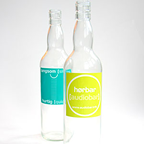
Hørbar/Audiobar
Hørbar/Audiobar is a responsive environment for natural and playful exploration of huge collection of audio art. You can interact with the sounds using a tangible interface based on RFID-tagged bottles. The environment consists of two rooms: A bar-room for shared interaction and a study lounge for more in deep explorations.
Hørbar/Audiobar will be premiered at the Museum for Contemporary Art in Roskilde, Denmark. This museum has a huge collection of international audio art which will be accessible at the bar. The installation is part of the exhibition Social_Action - The Audience and the New Media Landscape.
The exhibition opens on January 12th 2007 at 17:00 - 20:00 :: Address: Museet for Samtidskunst :: Stændertorvet 3D, DK-4000 Roskilde, Denmark. The project is supported by Kulturnet Denmark and Sound Forum Øresund.
Posted by jo at 06:12 PM | Comments (0)
December 06, 2006
www.mockingbirdproject.com

Global Soundscape
The Mockingbird Project is a streaming, real-time, non-repeating, self-generating experiment in sound. Mike Skinner loaded in some of his own sounds but the most exciting part to me him is the ability for users to contribute their own small sound clips to the system. His hope is that as word gets out about the site people from around the world will contribute thus making it a truly global soundscape. Enjoy. And pass the word...
In February of 2006, Mike started a series of ambient 8 track/feedback/tape loop sound installation experiments. (The results of these experiments can be heard as the bottom, "foundation" layers of the Mockingbird project). At the same time, Mike also knew the limitations of these experiments: they are finite entropic experiences limited by time/sound sources/tape. He began to envision an online incarnation which, theoretically, can last forever, can run and develop 24 hours a day, and does not depend on the longevity of tape/tape machines or Mike's presence to play them.
In March, Mike brought the online idea to Gunny over lunch at Eva's Health Food in the West Village. Mike saw Gunny as a fitting collaborator, as his interactive expertise, interest in consciousness studies and buddhist meditation, and general demeanor would bring an interesting angle to the project. Stravinsky, Mike said, suggested that music as he knew it died when it could be recorded: no longer was it communal and happening in real-time. Suddenly, you could pause, rewind, remix, repackage, and sell it. The two were inspired by the capability of the digital medium to restore things to their Stravinsky-ian state and to create a vaster communal experience than possible in even the biggest concert hall.
Gunny fell in love with the idea. But he wanted to take the concept of entropy further and allow anyone globally to upload their own sounds into the flow. The resulting unpredictable collisions of sound would be fascinating. What might it suggest if a sound clip of an everyday grocery list played on top of a voicemail declaring passionate love? This made sense to Mike. His interest in the open source biology movement and concepts of entropy in performance, as embodied in the work of Merce Cunningham and John Cage, made this a natural match. Gunny took the project back to Allentium and consulted with Creative Director Mutlu Isik. Mutlu found the idea inspiring. Gunny agreed to finance all costs of design and development. Gunny called Mike who could not believe that this scheme was going to become a reality.
Days and months of conversation ensued about the conceptual implications of technological choices (is it really real-time if the local client machine is the one performing the sound? Should we use Flash Media Server and shared objects or can we do it with client-side Flash, ColdFusion, and SQL Server? What about bandwidth restrictions ruining the real-time effect?). Allentium Interactive Developer Isaac Morales offered a whole unique plan for approaching the technology of the project. In the end, Mutlu's technology model won out. Mutlu's model: scheduled tasks in ColdFusion would compose the music (decide what clips would play at what future times). This gets stored in a SQL server database. When a user logs on, their local Flash file talks to a Coldfusion file which talks to the SQL server which determines which files need to be downloaded and on what server those files reside. Files download. They start to play. Rinse. Repeat. Part of the genius of Mutlu's model is that, like online video games, the only traffic going between the CFMX nervecenter and the PC are the coordinates for the music files. Everything else sits on file servers. This makes the application supremely scalable.
Once programming was finished -- completed entirely by Mutlu and Isaac as the first official project of the Allentium Lab -- Isaac set to work on developing the visual animation for each of the layers. Mutlu integrated that into the design of the home page. Mike and Gunny finally settled on a name for the project -- Mike's idea had been to call it the Mockingbird Project.
And thus the Mockingbird was born.
Posted by jo at 11:47 AM | Comments (0)
November 21, 2006
Spaces Speak, Are You Listening?
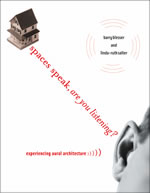
Experiencing Aural Architecture
Spaces Speak, Are You Listening? Experiencing Aural Architecture by Barry Blesser and Linda-Ruth Salter :: We experience spaces not only by seeing but also by listening. We can navigate a room in the dark, and "hear" the emptiness of a house without furniture. Our experience of music in a concert hall depends on whether we sit in the front row or under the balcony. The unique acoustics of religious spaces acquire symbolic meaning. Social relationships are strongly influenced by the way that space changes sound. In Spaces Speak, Are You Listening?, Barry Blesser and Linda-Ruth Salter examine auditory spatial awareness: experiencing space by attentive listening. Every environment has an aural architecture.
The audible attributes of physical space have always contributed to the fabric of human culture, as demonstrated by prehistoric multimedia cave paintings, classical Greek open-air theaters, Gothic cathedrals, acoustic geography of French villages, modern music reproduction, and virtual spaces in home theaters. Auditory spatial awareness is a prism that reveals a culture's attitudes toward hearing and space. Some listeners can learn to "see" objects with their ears, but even without training, we can all hear spatial geometry such as an open door or low ceiling.
Integrating contributions from a wide range of disciplines--including architecture, music, acoustics, evolution, anthropology, cognitive psychology, audio engineering, and many others--Spaces Speak, Are You Listening? establishes the concepts and language of aural architecture. These concepts provide an interdisciplinary guide for anyone interested in gaining a better understanding of how space enhances our well-being. Aural architecture is not the exclusive domain of specialists. Accidentally or intentionally, we all function as aural architects.
As a former Professor at MIT and a founder of digital audio, Barry Blesser has spent the last 40 years working at the junction of audio, acoustics, perception, and cognitive psychology.
Linda-Ruth Salter, Ph.D., is an independent scholar who has spent the last 25 years focusing on the interdisciplinary relationship of art, space, culture, and technology. [via iDC]
Posted by jo at 12:12 PM | Comments (0)
October 16, 2006
Oppera Internettikka - Protection et Sécurité
![]()
FearingS
What is fear? Why should you be afraid? What, who is to fear? Where does your fear come from? Participate in creating a collective voice about "fear". Help reveal its actual tendencies.
FearingS is a part of the project Oppera Internettikka - Protection et Sécurité by Annie Abrahams & Igor Stromajer.
Oppera Internettikka - Protection et Sécurité explores the poetics of a contemporary sound form -- live opera as a sound event for the audience in the form of a live internet audio broadcasting. In that way it combines the notion of the world wide web communication protocols and classical artspace -- an opera house. Opera is a very strictly coded form of art with a lot of passion, and internet is a lonely place of solitude and intimate communication which is becoming more and more fragile, dangerous and suspicious.
The theme of the project is security and protection, which refers both to private and personal safety issues in the present post-WTC world of high and intense but questionable security measures and to the internet as a global and therefore extremely vulnerable and unstable communication tool.
Three artists with specific roles (artist Annie Abrahams as mutter courage, intimate mobile communication artist Igor Stromajer as bigbrother and professional opera singer as French secret service agent) are performing a complex structure combined of sounds, voices, noises, internet audio files and sound-manipulating machines and are using these sounds to perform/sing/reproduce a story for the audience present in the opera house, and for those following the audio part of the project live on the internet worldwide.
The libretto for the opera is composed out of three sources -- mutter courage is using the texts written and proposed in advance by the online visitors, bigbrother's only lyrics comes from a web search engine which he is manipulating in realtime, and the secret service agent is singing the HTML source code (Hypertext Markup Language - the authoring software language used on the internet's world wide web for creating world wide web pages) and Java scripts (JavaScript is a script language - a system of programming codes that can be embedded into the HTML of a web page to add functionality) from specifically selected French secret service web sites, openly available on the internet.
It is a new media project filled with abstract emotions, created in a valuable tradition of Bauhaus musical theater mixed with Dada, sound poetry and contemporary digital means of expression. Therefore the location of L'Opéra National de Montpellier has been selected to emphasize our efforts of introducing new artistic forms and production processes to the audience.
Project supported by The Ministry of Culture of the Republic of Slovenia, The Ministry of Culture of the Republic of France, The Municipality of Montpellier, The Council of the Languedoc-Roussillon region and Rhizome.org 2006-2007 Commissions. Co-produced by Intima Virtual Base (Slovenia), Panoplie.org & bram.org (France)
Posted by jo at 06:15 PM | Comments (0)
Simon Elvins

Interactive & Audible Print
Simon Elvins, a graduate from MA Communication Art & Design at the RCA, has created a number of interesting works dealing with print as an interactive interface for sound.
Notation: “This is part of an ongoing exploration into sound, print and notation, and looks at ways of linking sound to the printed page. Using a simple sounder, the project aims to directly relate tonal values of pattern and drawing, into a tonal scales of sound and music”.
FM Radio Map: “This map plots the location of FM commercial and pirate radio stations within London.The poster works in its own right as a piece of information design, but when connected to the modified radio it becomes part of the interface. Each map is made site specific by connecting only the stations that can be received in that location. This is done by drawing power lines in pencil on the back of the map, which conducts electricity from the radio to the front of the poster.Placing a metal contact onto each point enables us to listen to the sound broadcast live from that location”.
Sound Book: “Writings on the use of sound within Art and Design. Includes interactive typography and audio CD which can be played through the book when connected to a CD player”. Related post: connect..draw..remix [blogged by Chris on Pixelsumo]
Posted by jo at 12:00 PM | Comments (0)
August 18, 2006
MPG: Mobile Performance Group
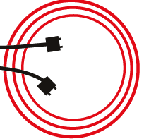
Art to Go
Founded by Matt Roberts, the MPG: Mobile Performance Group is a collective of new media artists interested in finding new ways to present art outside of traditional venues. MPG disseminates their work by using automobiles, video projection, cell phones, FM transmission, wireless hotspots, and any other technologies that allow artist to engage the public.
Parking Spaces investigates one of the most ubiquitous spaces in the United States, the parking lot. MPG moves through the city looking for empty parking lots to collect sounds and images. Using the collected material MPG creates an improvised performance in the space. Images from ZeroOne ISEA2006. Multi media feature from Mercury News. Flickr.
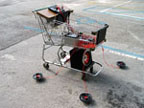
Shopping Carts: Using recycled cardboard, solar power, batteries and multimedia equipment, MPG converts shopping carts into modular performance units. During the day the carts are used to collect energy, sounds and images. Each cart is equipped with solar panels and batteries for energy collection. They are also equipped with audio/video recording equipment for sound and image collection. During the night carts carry panels, made of recycled cardboard, that allow several carts to connect and provide table space for the performers. The three basic carts are audio, video, and power. The audio module carries speakers, amps and mixing board. The video module carries video projectors, cameras, and lcd screens. The power module carries batteries, inverters and power strips to provide power for the performers.

Inflatables: A series of inflatables that can be used as performance space and projection screens. MPG is working with designer Gerry Christensen and a group of his students to create a series of apparatus for mobile performance. These apparatus include a bike trailer with a hybrid power source and wearables for performance space. The bicycle trailer is equipped with solar panels for energy collection and storage, and has the ability to tap into public power outlets. The trailers can cary multimedia equipment, local wireless network, and provide portable power. The wearable are portable devices that performers can wear to carry equipment and also convert into seating/table space for performance.
More information here. [thanks Craig]
Posted by jo at 10:29 AM | Comments (0)
August 08, 2006
Exploded Monologues
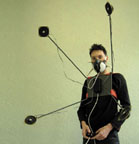
Transcending the Bodies' Boundaries
Exploded Monologues, by Troika, is a wearable machine that allows the user to literally send his voice on one or more of the four different speakers, each of them located approximately one meter from the mouth of the user. A control interface with four different buttons enables the user to choose where his voice will be heard. An additional mask containing a microphone is worn to prevent the listener from hearing the performers voice directly.
Exploded Monologues starts from a reflection on the dialogue through our new technologies of communication and the way they explode the boundaries of our bodies. Exploded Monologues is a performance tool that expands the possibilities of the narrative. The user is able to simulate different characters and play with the sonic space perceived by the listener. [via]
Posted by jo at 12:20 PM | Comments (0)
August 03, 2006
Turbulence Commission:
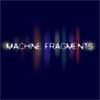
Machine Fragments
Machine Fragments by Onomé Ekeh :: Needs Flash player 8+ and speakers; optimized for Internet Explorer and Safari :: Perhaps the question, "Can Machines Think"? should be re-articulated as "Is the Machine different from you or I"? Why is there a perceptive gap between our tools and ourselves? Do they also not constitute consciousness and by extension the body?
The cultural schisms that generate this differentiation between "man" and "machine" are also responsible for spawning voids and displacements – and the ghosts that inhabit them. It is these ghosts who constitute "Machine Fragments." Machine Fragments are essentially sound fictions spun from the perspective of sentient machines, testing humans for machine intelligence. Not so much to expose the machinic dimension in humans (we suspected as much), but to arouse the sense that "Machine" is also a kind of gender.
"Machine Fragments" is a 2005 commission of New Radio and Performing Arts, Inc., (aka Ether-Ore) for its Turbulence web site. It was made possible with funding from The Greenwall Foundation.
BIOGRAPHY
Born and raised on most sides of the Atlantic, Onomé Ekeh started out as a painter, gravitated towards design and fell in love with cinema. The collusion effect is a lifelong fascination with hybrid forms of media and their perpetuation in contemporary culture. Ekeh has written for film, and literary and technological journals both in Europe and the United States; produced works for theater; and created "radio fictions." She is a frequent collaborator in a number of cross-disciplinary projects. She lives in New York City and has been the recipient of several fellowships and grant awards including the Jerome Foundation/Media Alliance (2000); Harvestworks Digital Media Center Artist-In-Residence (2002). Ekeh is currently a Fellow at the Kunstlerhaus Buchsenhausen in Austria.
Posted by jo at 03:51 PM | Comments (0)
July 31, 2006
Locus Sonus Audio Streaming Project
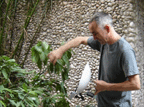
OPEN CALL
August 2006 :: This is a call from the French based Audio in art research group Locus Sonus to participate in their streamed soundscapes open web-mike project. Open an ogg audio stream from your home or garden (no pre-recorded playlists please) and become a remote member of the Locus Sonus orchestra.
Locus Sonus is a research group specialized in audio art (École Supérieure d'Art d'Aix-en-Provence, École Nationale Supérieure d'Art de Nice Villa Arson). Its objective is to experiment and evaluate the innovative and transdisciplinary nature of audio art forms in a lab-type context. It is also concerned with in the communal, collective or multi-user aspects inherent in many emerging audio practices and which necessitate working as a group. Two main thematics define this research - audio in it's relation to space and networked audio systems.
To participate in this project, contact support[at]locusonus.org :: to listen to the streams already available click here :: to download a PD patch and start streaming click here :: to see video documentation of our previous presentations and to find out more about Locus Sonus in general, click here.
NEXT PUBLIC EVENTS
Presentations start from 15th to 30th of August in various performance and installation situations, starting with DIGIT Delaware Delaware Valley Arts Alliance & Roebling Bridge Environmental Arts and LMCC (Lower Manhattan Cultural Council) in partnership with THE THING Inc. (New York) with the support of Étant Donnés, The French-American Fund for Contemporary Art.
Presentations continue in the fall with an installation during the Arborescence festival in Aix-en-Provence, France, and an installation performance at GMEM, Marseille France.
Festival DIGIT: http://www.artsalliancesite.org/programs/digit_06.html
LMCC: http://www.lmcc.net/
THE THING: http://bbs.thing.net/
Arborescence: http://www.arborescence.org/rubrique.php3?id_rubrique=3
GMEM: http://www.gmem.org/
TECHNICAL DOC
To Start Streaming You will Need :
* a PC or Mac dedicated to the stream (an old 450 MHz machine should do).
* a sound card recognized by your operating system.
* a microphone ($3 radioshack mike is fine).
* streaming software (we propose that you download our PD patch and run it using PureData that way you can customize your stream (for OSX, Windows and Linux). We recommend that you use this Hans Christoph Steiner's extended version which includes the necessary ogg vorbis libraries.
* a high speed internet connection and a network router.
We obtained the good results using the Dyne:bolic Linux distribution. The advantage being thats it's a liveCD (so you don't have to install the system) and that PD and all the necessary externals are already installed. You might run into difficulties if the system doesn't recognize the PCs built in sound card in which case the easiest option is to find an old soundblaster card and disactivate the built-in card in the bios.
It's important for us to get a wide range of soundscapes and social situations, remember that urban sound is pretty similar around the western world so you might want to chose to place your microphone so as to capture interesting or unique aspects of your environment and also to listen to the other current streams to caracterize yours.
We are also finding that in most circumstances it is preferable to customize the patch, sometimes a little filtering is all thats needed (as for example: port.ogg) but we've also built a sampling patch which records and plays back recent sound events continually updating its database (as for example: cap15.ogg).
Listen to the current streams.
Posted by jo at 10:56 AM | Comments (0)
June 30, 2006
panasonicEmotion
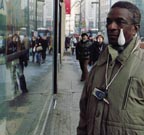
Audio-Prosthesis
The Panasonic Emotions Testing Line, by "nomadic" development designer JIŘÍ ČERNICKÝ, is a conceptual SD audio-prosthesis that aims to grasp the issue of the emotional deficits in society.
The device is a substitute, personal container for the emotions of users who are not able, or do not want, to experience life through their own emotional perceptions. It looks like a Walkman-type device with headphones that does not play music inside, but rather outside, of the head. The device facilitates the user's emotional communication with the world around him. It is not designed for his/her personal use only but is equipped with a tiny amplifier.

The memory of the SD Audio Player chip card contains a great amount of data containing recordings of authentic human emotions. For instance, if the user finds himself in a situation where he has to argue with someone, yet he does not want to get into confrontation and to waste his own emotions, he locates a password on his SD Audio Player representing an appropriate emotional response, which he then applies accordingly.
The SD Audio Player can also record and thus appropriate other people's emotions: sniveling, peevishness, sobbing, moaning, crying, gradual emotional collapse, breakdown, yelling by a beaten person, the state of mind between laughter and crying, the hysterical family argument from Fellini's film Amarcord, pubescent giggling, comforting and fondling of a baby, a feeling of well-being, enthusiastic effusions, wearing somebody out, cuddling, soothing, etc. Such recordings, including those from movies, can be further edited and modified on a computer. In this way, the user can appropriate the emotions that are conveyed by celebrities and other prominent individuals.
Via VVork. See also Ku: iyashikei-net by Urico Fujii and Ann Poochareon is a networked crying sculpture that allows people to communicate through the interface of tears. [blogged by Régine on we-make-money-not-art]
Posted by jo at 05:35 PM | Comments (0)
Suite Soil Digital Media

Two New Commissioned Audio Works
Concert, June 30, 2006, 8:00 p.m.: A live stream of the June 30th concert is available at this link under SPIKED.
Guy van Belle (Bratislava): "slashtops": The concert program "slashtops" consists of real time manipulations with sound transforming light to sound and sound to light in three parts to investigate the relationship between sound and image, audio art and the visual, a persistent tension in the arts for generations. The first part of the program is a trilogy of arrangements between synthetic and real sounds the source material and inspiration based on recordings made in Quebec based on the movement of the artbots that comprise 'thoughts go by air'. A second source of audio content comes from Munich based on sounds from the city environment and a third from Bratislava, around Zlaty Piesky (an industrial - recreational - commercial area). The second component of the program is based on a translation of light into sound using the computer as an instrument. The third part of the program is a concert version of the installation TICS, which is a translation of light into sound and back to light, with a score based on the novel 'istanbul' by the Turkish writer Orhan Pamuk (2006).
Biography: Guy Van Belle (working and living on the road and in Bratislava) has been prominently involved in the use and development of media for artistic purposes since 1990. Since 2000 xgz has been working under the name of the collective digital band mxHz.org (machine cent'red humanz), creating collaborative performances, concerts, workshops, exhibitions and unexpected experimental/abstract art projects. MxHz.org is co-organizer of the umbrella organisation okno, a non-profit technological art organisation situated in Brussels.
MxHz.org are currently developing 2 sets of autonomously communicating heliumbots. The title of the project is "thoughts go by air". Performances were set up in Brussels, Den Hague, and New York. The current new generation is being developed in Brussels (http://okno.be) and Berlin. A special focus for mxHz.org is on Balkan/Central/Eastern Europa to work towards a new sustainable kind of collaborative projects. A recent ongoing work - 2WR or two-way-radios - is a net-remake of John Cage's Imaginary Landscapes #4 (for 12 radios and 24 performers) based on some historical texts by innovative radio artists. The project started in Prague during the FM@dia conference 2004 and was recently set up as a networked installation at Skolska Prague. With Akihiro Kubota he started the Society of Algorithm in 2001, working on netbased music performances. They participate in festivals and connected concerts. Since 2005 open workshops were added and a residency exchange between Europe and Japan to expand the concept. Recently, they contributed to the Berlin Sonambiente Exhibition.
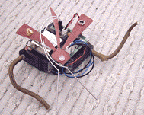
June 30 - July 29, 2006 - Installation: Peter Courtemanche's (Vancouver): "Preying Insect Robots", Opening reception Friday, June 30. Work created for the commission series, "Living with artificial beings" for Soil Digital Media Suite. Preying Insect Robots c. 2006 by Absolute Value of Noise.
Preying Insect Robots is a set of autonomous creatures that move about and communicate using a wireless Internet connection. These robots are modeled after an imaginary jade-green preying mantis - a mechanical creature that is described in the "Martian Chronicles" (by Ray Bradbury). The robots are adaptable to both indoor and outdoor environments - galleries, sidewalks, parks, and performance spaces. They engage in solo and choreographed group activities. The sound of their motors, motion and engagement creates an eerie soundtrack. The piece has a number of manifestations including an installation, a public intervention (performance), a web-presence, and an audio CD based on the sounds of the robots. As the robots wander, they transmit poetry to the Internet - creating montages of found text from a number of science fiction stories, including Feersum Endjinn (1994) and Excession (1996) by Iain M. Banks; The Martian Chronicles (1946 - 1958) by Ray Bradbury; Autofac (1955), Do Androids Dream of Electric Sheep (1968), and The Electric Ant by Philip K. Dick; Mortal Engines (1972 - 1976) by Stanislaw Lem; and For a Breath I Tarry (1966) by Roger Zelazny.
To hear the poetry created by the preying insect bots, go to this link;
http://www.soilmedia.org/preying/
Biography: Peter Courtemanche is a contemporary sound and installation artist from Vancouver. He is the Director and Curator of the Western Front's Media Arts Program - which supports the production and dissemination of experimental audio and electronic art. He has worked extensively in radio-art and electronic/interactive interventions. His art works often have a literary basis - inspired by narrative texts and the history of specific installation sites. As a curator, collaborator and producer he has worked with many established and emerging artists in the production and installation of video, audio, and computer/electronic based art.
Events take place at Neutral Ground
1856 Scarth Street, Regina, Saskatchewan
Curated by Brenda Cleniuk
For funding support, we thank the Canada Council for the Arts, the Saskatchewan Arts Board, Sask Lotteries Trust, the City of Regina and the Department of Canadian Heritage
Posted by jo at 04:42 PM | Comments (0)
June 27, 2006
Installations at Eyebeam
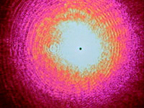
Modern Orthodox + EarthSpeaker
June 29 through July 15 Eyebeam is pleased to present three new installations developed in our studios exploring innovative uses of sound and light, both visible and undetectable, to fix and define spatial environments.
Elliott Malkin's Modern Orthodox is a working demonstration of a next-generation eruv installed on 21st Street in front of Eyebeam in New York City. An eruv (pronounced ey-roov [related]) is a symbolic boundary erected around religious Jewish communities throughout the world. While an eruv is typically constructed with poles and wires, Modern Orthodox employs a combination of low-power lasers, wifi surveillance cameras and graffiti, as a way of designating sacred volumes of space in urban areas.
The eruv is an ancient architectural construct that stems from the observation of the Sabbath, the sacred day of rest that includes a prohibition against certain kinds of work, including the carrying of objects outside of one's home, or private domain.
The presence of an eruv allows some carrying on the Sabbath by symbolically converting the shared public space within its boundaries into the shared private space of a community. In this way, observant Jews can carry objects such as keys or prayer books while acting in accordance with sacred Talmudic principles.
Because the physical integrity of an eruv is essential to its symbolic function, a breach in any portion of it renders it useless, which is why the entire circumference of an eruv, usually miles in length, is customarily inspected prior to every Sabbath. Malkin's laser eruv, however, which relies on a continuous stream of photons rather than cords and wires, is not as susceptible to permanent breakage. A branch of a tree, for example, may impede the flow of photons but will not permanently damage the eruv apparatus. In this way, the laser eruv is self-healing. Malkin also uses surveillance cameras to monitor the laser eruv connections from a remote location, allowing eruv managers to identify obstructions more efficiently. The content of these video transmissions are displayed at Eyebeam as part of the installation of this work.
Elliott Malkin is a new media artist whose work explores the use of everyday objects invested with the power to "sanctify" space. His most recent work, Modern Orthodox, focuses on the eruv, a symbolic boundary used as part of the observation of the Jewish Sabbath. Elliott's other work includes eRuv, a virtual reconstruction of an eruv that once existed on the Lower East Side of Manhattan – and Crucifix NG, a next-generation crucifix that broadcasts a radio frequency version of The Lord's Prayer. Elliott is also investigating the way religion and technology combine to inform the construction of memorial sites. Elliott is originally from Chicago and lives in New York City. He also works as an Information Architect.
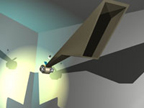
Jeff Feddersen's EarthSpeaker is series of large-scale autonomous, solar-powered sculptures. Drawing their inspiration from dusk-active creatures like crickets, bullfrogs and fireflies, they are designed to absorb and store solar energy during the day and retransmit the energy as acoustic sound for a brief period at dusk. As the sun sets, the system will create a short, distributed chorus of sound until the energy stored for the day is consumed. EarthSpeaker was commissioned as a permanent installation at free103point9's Wave Farm in Acra, NY where it will be transported to after exhibiting at Eyebeam. The challenge of creating a long-term installation, in a harsh environment, using available ambient energy pushed Fedderson's exploration of energy storage, alternative speaker functions and artistic design.
Jeff Feddersen is an artist, musician, and engineer interested in new musical instruments and sustainable energy. He has developed several new means of musical expression, including robotic sonic sculptures, real-time composition software, multi-modal digital input devices, and amplified acoustic instruments. He has exhibited and performed at the Chelsea Art Museum, the Apple Soho Store, and UC Irvine's Beall Media Arts Center, and the Lincoln Center. He has taught electronics, sustainable energy, and digital audio at NYU’s Interactive Telecommunications Program, where he was also a Resident Researcher, and has worked for the Technology Development group of Honeybee Robotics.
Posted by jo at 10:49 AM | Comments (0)
June 01, 2006
Invisible Maze
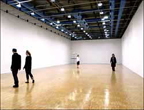
You Make It
Jeppe Hein's Invisible Maze installation is just what its title says: invisible. The promised maze is there but it only materialises as we move around in it. Visitors are equipped with digital headphones operated by infrared rays that cause them to vibrate every time they bump into one of the maze's virtual walls. Thus, the exhibition is perceived as a both minimalist and a spectacular playground. The maze structure spans six different variants, all of them referring to labyrinths from our common cultural history. From the medieval labyrinth in Chartres to Stanley Kubrick's fateful dead end from the film The Shining to Pac-Man. The maze changes from day to day, inviting visitors to make repeat visits.
Statens Museum for Kunst in Copenhagen will present Jeppe Hein: Invisible Maze 10 June - 27 August 2006. The exhibition represents a further development of the exhibition Invisible Labyrinth which attracted 50,000 visitors during its two-month run at the Centre George Pompidou in Paris last year. Via Art Daily. Thanks Joshua. Other work by Jeppe Hein: Distance.
More sound-based spatial installations: audio space + audiotag + audio graffiti, Mapamp, Sonic city, sound mapping, Aura, Akitsugu Maebayashi's audio work, Audio Viscera, electrical walks, aetherspace, etc. [blogged by Régine on we-make-money-not-art]
Posted by jo at 10:15 AM | Comments (0)
May 31, 2006
16 Horsepower
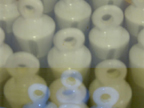
Body Modification and the "Internet of Things"
16 Horsepower, by Meghan Trainor, is a performance piece in which Trainor scans pieces of ceramic and graphite embedded with RFID tags to trigger different sounds from an audio database culminating in a series of tracks triggered by a RFID chip in her arm. This piece aims to help the audience understand and imagine the coming "Internet of Things" as well as emerging capabilities to modify the human body.
Trainor collaborated with ceramicist Michelle Anderson and programmer Stephen Koch. Anderson created 16 ceramic plumb bobs that walk a line between handmade and mass-produced objects. Koch built an application in Flash that allows her to rapidly and easily create and manage audio dense RFID projects. This piece will be debuted at the upcoming Ask the Robot show on June 4th, 2006.
Previous RFID projects: With Hidden Numbers, 2005 [video], Radio Frequency Remix, 2005 [video], RFID Project, 2004 [video].
Posted by jo at 04:26 PM | Comments (0)
May 25, 2006
IN[ ]EX
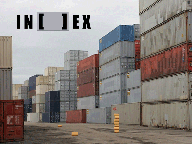
Container Culture
Panel Discussion: RHYTHMS OF URBANITY: MAPPING THE PUBLIC SPHERE THROUGH SOCIO-POLITICAL FORCES--Thursday, May 25 at 7 pm; Room 403, Vancouver Art Gallery.
This public discussion among artists Kate Armstrong, Bobbi Kozinuk, M. Simon Levin, Laurie Long, Leonard Paul, Manuel Piña, Jean Routhier, and curator Alice Ming Wai Jim will speak to “container culture” and the idea that the public sphere is rapidly being privatized and now reflects more on the movement of goods and capital than on the expression of individual rights. in[ ]ex, their interactive, city-wide media art project, will first be exhibited in connection with Centre A and the World Urban Forum in Vancouver, Canada in June 2006, and then in San Jose, California in connection with the Container Culture exhibition at ISEA in August.
In[ ]ex is an audio sculpture which creates a mesh network by releasing thousands of embedded wooden blocks into the world. The mesh network collects and processes data to form a sound environment in the space of a shipping container. This project takes place in the context of shipping and distribution of goods and the movement of people in the two port cities of Vancouver, British Columbia, and San Jose, California. In[ ]ex engages both the subject of things and the mechanisms by which things are distributed in the global economy.
Posted by jo at 10:12 AM | Comments (0)
May 23, 2006
Paul DeMarinis

The Messenger Delivers a Golden Nica
The Messenger (1998) by Paul DeMarinis has been awarded the Golden Nica for Interactive Art by Prix Ars Electronica 2006. In The Messenger, email messages received over the internet are displayed letter by letter on three alphabetic telegraph receivers: a large array of 26 talking washbasins, each intoning a letter of the alphabet in Spanish; a chorus line of 26 dancing skeletons and a series of 26 electrolytic jars with metal electrodes in the form of the letters A to Z that oscillate and bubble when electricity is passed through them. Movie.
"The Messenger is an internet-driven installation based on early proposals for the electrical telegraph, in particular those made by the Catalan scientist Francisco Salvá. As in many of my works I examine the metaphors encoded within technology, especially lost or orphaned technologies and try to trace their origins, speculating on the way that mechanisms are the repositories of larger unspoken conceptions and dreams. In The Messenger I take the telegraph as a point of departure from which to examine the relationship between electricity and democracy, and how electrical telecommunication technologies have participated in our solidarity and in our isolation, in our equality and our oppression, in the richness of our experience and the uncertainty of our lives." -- Paul DeMarinis
Paul DeMarinis has been working as an electronic media artist since 1971 and has created numerous performance works, sound and computer installations and interactive electronic inventions. He has performed internationally, at The Kitchen, Festival d'Automne a Paris, Het Apollohuis in Holland and at Ars Electronica in Linz and created music for Merce Cunningham Dance Co. His interactive audio artworks have been shown at the I.C.C. in Tokyo, Bravin Post Lee Gallery in New York and The Museum of Modern Art in San Francisco. He has been an Artist-in-Residence at The Exploratorium and at Xerox PARC and has received major awards and fellowships in both Visual Arts and Music from The National Endowment for the Arts, N.Y.F.A., N.Y.S.C.A., the John Simon Guggenheim Foundation, the Rockefeller Foundation New Media Award and the D.A.A.D. Berlin Artist Fellowship.
Much of his work involves speech processed and synthesized by computers, available on the Lovely Music Ltd. compact disc "Music as a Second Language", and the Apollohuis CD "A Listener's Companion" Major installation works include "The Edison Effect" that uses optics and computers to make new sounds by scanning ancient phonograph records with lasers, "Gray Matter" that uses the interaction of body and electricity to make music, and "The Messenger" and "Firebirds" that examine the myths of electrical communication. Public artworks include large scale interactive installations at Park Tower Hall in Tokyo, at the 1996 Olympics in Atlanta and Expo 1998 in Lisbon and an interactive audio environment at the Ft. Lauderdale International Airport in 2003.
Posted by jo at 01:36 PM | Comments (0)
May 19, 2006
SOLAR RADIO STATION

Sounds of the Universe
SOLAR RADIO STATION, a project by RIXC, Center for New Media Culture, Riga (LV) and r a d i o q u a l i a (NZ / AUS / GB / NL); PHOENIX Halle Dortmund; May 20 - July 16, 2006; Opening: Friday, May 20, 2006, 18:00.
In this (live) installation one can listen to the sounds of the universe originating from various sources. They have been collected by the artists' group r a d i o q u a l i a (Honor Harger, Adam Hyde) in cooperation with RIXC, Center for New Media Culture, Riga. The recordings are coming from various radio telescopes. Additionally, during two days, there will be live feeds from the VIRAC radio astronomy telescope in Irbene (Latvia) which will be acoustically re-worked and interpreted live by the experimental musicians Clausthome (Latvia). VIRAC is the largest radio telescope worldwide (with a dish diameter of 32 meters) accessible for civilian use - thanks to RIXC's continued efforts. During the cold war the KGB used the radio telescope for tapping into NATO's and other military networks.
The installation “Solar Radio Station" consists of three parts. r a d i o q u a l i a's computer and sound installation “solar listening_station" is the first part. It contains recordings and live streams of radio waves from space, especially from the sun. The second part “Spectrosphere" also contains signals originating from the VIRAC radio telescope, this time modulated via electronic instruments and interpreted visually. Here, Clausthome and VJ Ratniks present the results of their live performance from May 20 + 21 at PHOENIX Halle until July 16, 2006. The third part consists of a comprehensive video documentation of the VIRAC telescope by RIXC. Additionally, on a large scale poster the existing frequency spectrum is visualized and its current use is explained.
LIVE INSTALLATION: Sat + Sun, May 20 + 21, 2006, 19:00 - 21:00; The Riga based group Clausthome and VJ Martins Ratniks (F5/RIXC) will perform live in the Solar Radio Station. The live audio stream from the VIRAC radio telescope in Irbene, carrying data from the sun and from space, will be electronically enhanced by Clausthome and interpreted visually by VJ Martins Ratniks.
LINKS
www.museumamostwall.dortmund.de
www.hmkv.de
www.rixc.lv
www.radio-astronomy.net
www.virac.lv
A project by RIXC, Center for New Media Culture, Riga (LV) and r a d i o q u a l i a (NZ / AUS / GB / NL).
RIXC (LV) - Raitis Smits, Rasa Smite, Martins Ratniks, Davis Bojars r a d i o q u a l i a (NZ/AUS/NL/GB) - Adam Hyde, Honor Harger Clausthome (LV) - Lauris Vorslavs, Girts Radzins
In the framework of the exhibition "mit allem rechnen. Medienkunst aus Estland, Lettland und Litauen / face the unexpected. Media art from Estonia, Latvia and Lithuania" - a cooperation between Hartware MedienKunstVerein and Museum am Ostwall, Dortmund/Germany.
SUPPORTED BY: Kulturbuero Stadt Dortmund, 38. internationale kulturtage der stadt dortmund / scene: estland lettland litauen in nrw, Kunststiftung NRW, Der Ministerpraesident des Landes Nordrhein-Westfalen, Kultusministerium der Republik Estland, Kultusministerium der Republik Lettland, Kultusministerium der Republik Litauen, Botschaft der Republik Litauen in der Bundesrepublik Deutschland, Lietuvos Institutas, dortmund-project, LEG, PHOENIX, Medion, Coolibri (Medienpartner).
VENUE: Hartware MedienKunstVerein at PHOENIX Halle Dortmund, Rombergstr. / Ecke Hochofenstr. (no postal address!) Dortmund-Hoerde, Germany.
ADMISSION: PHOENIX Halle: 4 Euro, reduced 2 Euro (incl. admission to the exhibition "Glamour and Globalization") Kombiticket Museum am Ostwall and PHOENIX Halle: 6 Euro, reduced 3 Euro (incl. admission to the exhibition "Glamour and Globalization")
HOW TO GET THERE http://www.hmkv.de/dyn/e_contact_roaddescription/
CONTACT
Hartware MedienKunstVerein
Guentherstraße 65
D - 44143 Dortmund
Germany
Tel: ++49 - 231 - 823 106
www.hmkv.de
Posted by jo at 10:51 AM | Comments (0)
April 25, 2006
Seeing Sound
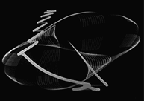
Abstronics: Mary Ellen Bute
Mary Ellen Bute has cropped up at Dataisnature before whilst talking about methods for visually representing sound - but in that instant, only a mention. Although hardly know today, her pioneering, highly experimental films were watched by millions at the time, as they were played as ‘shorts’ preceding the main features film in theatres showing across the States.
After studying Lighting, she mixed with the likes of Leo Theremin and Thomas Wilfred, whose Colour Organ, the Clavilux, definitely left an impression on her.
Later on, impressed by the mathematical musical systems of Joseph Schillinger, which she incorporated into her methodologies, she began to make abstract-geometric animations that represented music. Undoubtedly she was influenced by the great musical animations of Oskar Fischinger. From 1939 she began to work in colour, employing the used of oscilloscopes; using this technique she made two fairly well know films, Abstronic and Mood Contrasts.
Although very hard to track down, sound responsive computational artists would surely understand, enjoy, and perhaps learn from the work of Bute, as well as the more widely know Fischinger, of course. [blogged by Paul on Dataisnature] [Related: Shape of Song]
Posted by jo at 09:18 AM | Comments (0)
Pierre Proske'S

Voiceprints
An Australian digital artist is using his voice to design textiles. Pierre Proske has developed computer software that translates different frequencies in someone’s voice into spiral patterns, producing what he calls ‘voiceprints’. Proske developed the software while doing his masters in art and technology at Sweden’s IT University of Göteborg.
He’s used the software to design a pattern inspired by elements of Japanese textiles, a design that appeals to him because of its simple repeated elements. "Computer code is very simple and minimalistic, you have these ones and zeros, so I thought it would be good to choose a very minimalistic textile as well."
The textile is made up of repeated spirals of more or less the same size in a particular dense and fairly regular arrangement. Proske then scanned one of the spirals into his computer as the basic element in his voiceprint design. Next he used the software to analyse the frequency profile of a short sample of a voice. "You might get a bunch of low frequencies and some high frequencies depending on what you say and how you say it," he says.
The software translates the relative amounts of different frequencies of a particular sound into a particular layout of spirals of different sizes. Different voice sounds can create different layouts of the spirals, says Proske. He says the software could be used to generate patterns for textile and graphic design. "The idea is that it is actually meant to be quite accessible. Anybody could use their voice to generate these patterns."
Proske sees his research as a modern take on old technologies. "I’m kind of inspired by the connection of textiles and computers because they have a historical link that goes back to the automation of the loom in the 1800s," he says. Proske says the same punched cardboard cards used to code for textile patterns were later used to program the first computers. [blogged by Regine on TWENTY1F]
Posted by jo at 09:11 AM | Comments (0)
March 28, 2006
Invisible-5 Audio Project

Self-Guided Critical Audio Tour
Invisible-5 is a self-guided critical audio tour along Interstate 5 between San Francisco and Los Angeles. It uses the format of a museum audio tour to guide the listener along the highway landscape. Download the audio files individually or compiled for CD!
Invisible-5 investigates the stories of people and communities fighting for environmental justice along the I-5 corridor, through oral histories, field recordings, found sound, recorded music, and archival audio documents. The project also traces natural, social, and economic histories along the route.
Posted by michelle at 01:10 AM | Comments (0) | TrackBack
March 15, 2006
Amy e Klara, machinic male - dicta
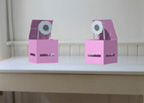
We are a Body
According to Pasolini, 'we don't have a body, we are a body'. Accepting this principle, in a society that traditionally tends to separate mind from body, would change both the social and the linguistic taboos. Changing the body, in fact, would modify also the perception of foul language. With Amy e Klara, Marc Bolhen explores this principle using synthetic speech. The involved bodies are two pink boxes, two machines, which speak with a feminine voice generated by 'text to speech' and automated speech recognition softwares. Should one box start to speak, the other might respond. One bad word leads another and the outcome is rather unpredictable. There are many similar artworks based on 'text to speech' application, like A Soap Opera for Imacs, Chant or Virologic Conditioning, but the choice of this slice of language makes Bohlen's work original. If the synthetic speech has achieved such levels of 'naturalness' that it can be confused with the voice of living human being, it is usually highly selective and optimized for commerce, plain, without exclamations. The fact that two machines quarrel and use foul language makes the situation more realistic and, according to the author, gives a real example of the future interactions between machines and human beings. -- Valentina Culatti, NEURAL
Posted by jo at 01:27 PM | Comments (0)
January 31, 2006
Speak Softly
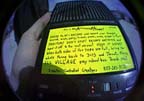
Automated Hobo Recording Project
This image is from the California high-desert bacchanal Burning Man, during which Mark G. circulated Automated Hobo, a sound-harvesting experiment using cheap tape recorders and hand-written instructions.
I purchase cheap tape recorders at thrift stores and wherever, load them with batteries and blank tape, and write instructions on the outside that tell people to record something and then pass it on to someone else. When the tape’s full, return it back to me. I figured that since Burning Man emphasizes participation over spectatorship, I might get better response than I have in the past. I was right — three out of four recorders came back, and the highlights can be heard here.
Mark G. is with Evolution Controlled Creations (a.k.a. the intellectual-property renegade band Evolution Control Committee). Automated Hobo MP3 files are available for download, although apparently they are from 2000, while the photo is from a more recent festival. Recordings from the project have also been broadcast - knowing ECC they may also have been sampled into current or forthcoming musix.
One of the interesting aspects of found-sound is its uncontrolled nature… one can imagine a similar process whose intermediate point is a speech-to-text system. What wild writings and miswritings might emerge from the text-to-speech transcript of an itinerant tape recording? [blogged by Jeremy Douglass on WRT]
Posted by jo at 08:49 AM | Comments (0)
January 20, 2006
Audio/Viscera
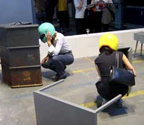
Sound Architecture
Audio/Viscera--by John Rothenberg--explore ways in which sound can be treated as an architectural material. The user wears a helmet containing wireless headphones. Their motion, tracked by a computer vision system, determines the sound they will hear and it serves the secondary purpose of redefining the soundscape.
Sounds (both live and recorded audio) are assigned to specific virtual locations, and are broadcast to the headphones as if they actually inhabited that space. Physical objects and images guide the user to these virtual sounds in the gallery. Somes sounds move through the soundscape, responding to the user’s motion and allowing her/him to discover and alter the virtual audio landscape.
Audio/Viscera aims to give architectural elements (like a wall or column) a voice. This is achieved through two channels: (1) a map of the audio events taking place in the city of Munich: as the user approaches the screen, s/he can hear (pre-recorded) sounds taking place at various locations throughout the city; (2) live but distant sounds are translated from throughout the exhibition and exterior spaces into the soundscape. The user is thus able to cross physical/architectural boundaries with sound, much as a window allows the user’s eye to cross physical boundaries in conventional architecture. These sounds will be connected to visual clues in the form of images or animations, or they will respond to the user’s motion.
This project explores the interaction between virtual and real space through sound. PDF of the project. Related: audio space + audiotag + audio graffiti, Mapamp, Sonic city, sound mapping, Aura, Akitsugu Maebayashi's audio work. [blogged by Regine on we-make-money-not-art]
Posted by jo at 02:39 PM | Comments (0)
January 19, 2006
Computational Poetics at Upgrade Vancouver
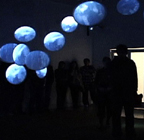
One River (running)
Join us Thursday, January 26th at 8pm for a discussion with Kenneth Newby, Martin Gotfrit, Aleksandra Dulic and Dinka Pignon, who will show us One River (running) and talk about their work with the Computational Poetics Research Group. As always, we will adjourn after the talk to the Whip Gallery [209 east 6th avenue] for a drink and some chatter.
One River (running) is an interactive, immersive audio environment designed to create both a visual and audio experience of rivers using a complex system of moving sound, moving images, and a physical structure also designed to echo the river¹s undulating geographic form. The artwork¹s images originate from digital photographs of people¹s mouths whom the team interviewed. These still images were then algorithmically programmed. The mouths recognize the voices, and move as though they are speaking the words they hear. The artists created a voice recognition software program to do this synchronization. The video is listening and responding to the audio. The piece was recently exhibited at the Surrey Art Gallery.
Kenneth Newby, Martin Gotfrit and Aleksandra Dulic are part of the Computational Poetics Research Group, a research project that works at the intersections of art, culture and computation and aims to articulate some of the features of an emergent poetics of digital art performance while developing a tool-set to enable artists working in the computational medium to create, present and document their work. A key objective of their work is to share the compositional process and the issues that arise in the work of interdisciplinary computational media performance. Contemporary computational techniques enable creative and performing artists to enter into new collaborative relationships with encoded systems.
Upgrade! Vancouver
When: Thursday, January 26 at 8pm
Where: Western Front, 303 East 8th Avenue, Vancouver, Canada FREE! Everyone welcome.
Posted by jo at 09:39 AM | Comments (0)
November 09, 2005
ORTPLAY@ORT
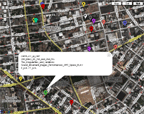
Can I order my eggplant?
ORTPLAY@ORT (330 Ellery St., 1st + 2nd Floors), as a part of BAP (Bushwick Art Projects)--Sat. Nov. 12, 2005, approximately 4 - 11 p.m.
music and sound, installed, performs. dance improvises. space gets invested. a climate occurs. text is produced and pronounced. projects on screen, an instigation, an animation, fashion. play. two floors, a rooftop, nesting spaces like Russian dolls unfold against and into each other. live. work. play.
o.blaat (Keiko Uenishi) premiers a new region-specific installation/live performance, 'Can I order my eggplant?' (berenjena). She will explore Chinese take-out restaurants on her bike in her Bushwick neighbourhood, desperately looking for her favorite 'eggplant'!
join our txtmob! if you have a mobile phone which can receive text messages, you can get instant updates & secrets from ORTPLAY throughout its performance/salon hours.
Posted by jo at 08:05 AM | Comments (0)
November 08, 2005
HER NOISE
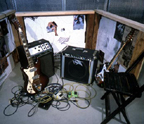
Sounds Investigate, Inspire, Uncover
Her Noise is an exhibition featuring five newly commissioned works by international artists whose practice shares the use of sound as a medium to investigate social relations, inspire action or uncover hidden soundscapes. New works by Kim Gordon with Jutta Koether; Emma Hedditch; Christina Kubisch; Kaffe Matthews and Hayley Newman all involve high levels of participation and are set in motion only when used by visitors or performers forming a base for events, live music and performances. [review]
In Reverse Karaoke [AuToMaTiC mUsIc TeNt] Kim Gordon and Jutta Koether aim to demystify the process of music making by creating a space in which audience members can record a track along with the pre-recorded sample of Gordon’s voice. The installation doubles as a performance space for a series of performances including Jenny Hoyston (Erase Errata), Heather Leigh Murray, Christina Carter, Ana Da Silva (The Raincoats).
In her installation Mini Flux Hayley Newman reproduces, in miniature, over a thousand objects used in the Sixties Fluxus movement's musical scores. The installation becomes a score in itself through Newman's invitation to guest artists to devise performances using the objects. Guest artists include The Bowman Brothers, Gluzberg and Bruce Gilbert.
Christina Kubisch has for many years been developing electrical walks which make audible the otherwise undetectable sound waves generated by the electromagnetic signals that surround us. Visitors are invited to navigate Kubisch’s maze of wires at South London Gallery, containing sounds from city walks using the specially designed headphones. Across town, visitors can pick up the headphones from the Goethe Institute to discover the hidden soundscape of the area according to Kubisch’s map.
In We’re Alive, Let’s Meet Emma Hedditch sets up a series of get togethers that will take the form of weekly meetings, workshops and talks with guests including film maker Vivienne Dick, Tobi Vail and Alison Wolfe (of riot grrrl bands: Bikini Kill and Bratmobile).
Hedditch has also collaborated with the show’s curators on the Her Noise Archive which combines a research area, listening posts and a viewing space filled with documentation of both historical and contemporary luminaries working in the field of sound installation and performance. The space contains books, fanzines, records, catalogues as well as exclusive on camera interviews and concert footage with artists including Pauline Oliveros, Maryanne Amacher, Diamanda Galas, Marina Rosenfeld, Thurston Moore, Kevin Blechdom, Kembra Pfahler, Kim Gordon, Lydia Lunch, Peaches and many others filmed in the process of developing Her Noise and aimed at forming a research archive which will become publicly accessible in London after the end of the Her Noise tour.
While lying on Kaffe Matthews Sonic Bed Laboratory the visitor becomes physically affected by a spectrum of sound vibrations shifting underneath and around as they lie. The 12 channel sound system immersed in the bed plays a specially constructed sound work, vibrating through and moving around the visitor. Sonic Bed Laboratory plays music to feel rather than just listen to.
This exhibition is the largest component of a HER NOISE programme of installations, events, performances and screenings by a wide network of artists whose practice involves the use of sound as a medium.
Curated by Lina Dzuverovic and Anne Hilde Neset, Electra
10 NOV – 18 DEC 2005
South London Gallery
65 Peckham Road
London SE5 8UH
Tel: 020 7703 6120
EXHIBITION CATALOGUE
Her Noise catalogue published by Forma,
Editors: Lina Dzuverovic & Anne Hilde Neset
Artists: Kim Gordon & Jutta Koether, Emma Hedditch, Christina Kubisch, Kaffe Matthews, Hayley Newman, Marina Rosenfeld
Contributors: Jan Avgikos, Christoph Cox, Drew Daniel, Anna Dezeuze, Louise Gray, Alan Licht, Thurston Moore, Rob Young
This catalogue forms an invaluable resource, highlighting the often overlooked contribution of women artists to the development of genres as disparate as Fluxus, performance art, punk and sound based installation. Through a wealth of images, essays and interviews the catalogue explores how the energy of independent music communities and open-access composing techniques can reinvigorate the exhibition environment.
All texts in English / 230mm °— 170mm, 68 pages, soft cover, illustrated colour throughout. ISBN: 0-9548288-1-X
Distributed by Cornerhouse Publications
Published by Forma forma.org.uk
South London Gallery
65 Peckham Road
London SE5 8UH
http://www.southlondongallery.org
Tel: 020 7703 6120
Her Noise is curated by Lina Dzuverovic and Anne Hilde Neset and produced by Electra (http://www.electra-productions.com) in association with Forma (http://www.forma.org.uk). The project is funded by Arts Council England, PRSF, The Henry Moore Foundation, The Elephant Trust, Women In Music, Feminist Review Trust with additional support from The Goethe Institute and Tate Modern. Media partner: The Wire Magazine.
Posted by jo at 09:35 AM | Comments (0)
October 12, 2005
Placing Voices
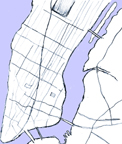
mobile-sound-blog
Voices of strangers heard in passing are key threads in the fabric of urban experience, subconsciously coloring our perception of a place. Yet such features are inherently unrepeatable, unique to every individual's listening experience, and, unlike a photograph, the location of a recording is difficult to recognize. Placing Voices, by Brian House, is a mobile-sound-blog software which uses the built-in sound recording feature of mobile phones (which is optimized for voice) and MMS messaging to place these fragments on a web-accessible map of the city as they occur. The objective is to express a map in terms of these experiences, to restore some claim to my memory of physical spaces over the transient voices heard within them.
Posted by jo at 05:03 PM | Comments (0)
October 10, 2005
The Cloud Harp
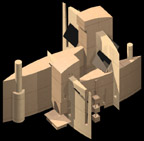
Cloudscapes
The Cloud Harp is a meteo-electronic installation that converts real-time, thanks to an infra-red laser beam and a telescope sharing the same optics, the height, density and structure of clouds into sounds and musical sequences. The melodies and sounds are determined by factors such as cloud height, density, structure, luminosity, and meteorological conditions. Each cloudscape produces a particular kind of sequence. The Harp is polyphonic : it can sing on many different voices simultaneously, each one being mapped on a specific altitude range. It sings 24 hours a day, 365 days a year, by any weather. When the sky is blue, it remains silent. The range of the instrument is 25 000 feet or 8 kilometers, which means that some high stratospheric clouds, such as cirruses, are not detected.
On a technological point of view, the Harp is similar to a giant CD player, turned upside down. In compact disc technology, a small lens captures a tiny laser beam modulated by microscopic holes on the surface of the disc; a decoding system converts the modulations into music or sound. Here, the small laser beam is replaced by a large infrared one; the lens is replaced by a telescope; the role of the compact disc is played by the cloud itself.
The Cloud Harp is also known as the Keplerian Harp, after the German astronomer Johannes Kepler, who was one of the first, with his "Music of the Spheres", to attempt the transposition of a natural phenomenon into music.
Posted by jo at 03:47 PM | Comments (0)
September 30, 2005
With Hidden Numbers
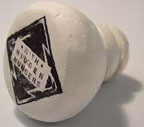
RFID Audio Mixer
With Hidden Numbers, by Meghan Trainor, uses embedded RFID tags to trigger an audio database and illustrate a technology that promises to become more prevalent in the coming years.
Dozens of handmade objects created with plaster, rubber and other traditional sculpting materials, each contain a unique number broadcast with a passive RFID tag. In addition the artist herself had a RFID tag embedded in her arm.
The system allows the audience to handle and scan the objects to activate audio triggers. Depending on the objects selected the result can be like a physical audio mixer, sometimes like a physical database query. The artist could trigger events with the tag in her arm as well, even when physically separated from the installation.
From the article The Accidental DJ in the WW Daily:
"When Trenor holds one of the objects near a scanner, it triggers a recording of an authoritative male voice reading numbers. When she waves the scanner over her arm, it plays "Hey Mamy, you sexy, you beautiful" from the rap song by Fannypack. Soon, she's holding two objects at once, dancing and interweaving samples of sound like a DJ scratching on vinyl."
The title references Marcel Duchamps’ 1916 sculpture With Hidden Noise which examined the concept of mass-production and was inserted with a noise making object unknown to Duchamp.
See also her Junkie's Little Helper. [blogge by Regine on we-make-money-not]
Posted by jo at 08:30 AM | Comments (0)
September 29, 2005
ResonanCity
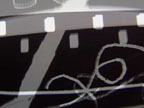
@ the Dutch Film Festival
Live performance ResonanCity by Sara Kolster and Derek Holzer, October 3, 20.00 uur; Dutch Film Festival/Re:visie, Centraal Museum [Post CM building], Utrecht NL.
Many sounds and images in our everyday lives slip past our notice simply because they are too small, or because we lack the proper receivers to pick them up. ResonanCity is an ongoing project to gather these microscopic sounds and images from various cities, and to amplify and transform them. The goal is to build a new city of sound and visuals inside the old one, and to inspire curiosity and exploration of one's own environment. Visually, Kolster's work deconstructs the analog/digital divide by presenting carefully prepared film positives in a software-manipulated environment. Similarly, Holzer's realtime digital sound treatments highlight and enhance rather than obscure and distort the field recordings and sound objects he collects. ResonanCity recently won the second prize at the WRO International Media Arts Biennale in Wroclaw, PL. See also http://www.umatic.nl [Related]
Dutch Film Festival / Re:Visie
During the Dutch Film Festival [28 sept - 7 oct] a second edition of the visual art program Re:Visie is presented. Curators Annet Dekker (Dutch Institute of Media Art, Montevideo/Time Based Arts] and Karel Doing [Film maker and co-founder of the Filmbank] put together a program in which interaction between different art disciplines is the central theme.
The performance ResonanCity is presented on the 3rd of October within the Re:visie program. Besides ResonanCity, two other performances - FACES (Joost van Veen & Huib Emmer) and OPTICAL MACHINES (Rikkert Brok & Maarten Halmans) will be presented on the evening of the 3rd.
Location: Post CS building
Re:Visie takes place in POST CM, Agnietenstraat in Utrecht. The entrance is opposite the main entrance of the Centraal Museum.
Posted by jo at 08:15 AM | Comments (0)
September 20, 2005
Remain in Light

Netting Ambient Analog Sound Waves
[...] Remain in Light, by Haruki Nishijima, is a visual representation of ambient analog sound waves captured using an "electronic insect-collecting kit." The "collector" carries an insect net that functions as an antenna and is attached to a device designed to capture the waves. Participants walk outside with the net. Through headphones, they can listen to phone conversations, AM radio, taxi drivers’ and police radio communications. A button on the handle allows collectors to record one-second sound bites.
These fragments of analogue information are transmitted to a computer that transforms them into points of light that are then projected onto the exhibition space. Each frequency is represented by a different colour. When visitors enter the space, their presence and movements are detected by sensors. This is how the "electronic insects" are activated, disperse then progressively disappear. Each light source is accompanied by a sound. The installation can be activated on the Internet. Remain in Light was part of the Touch Me festival in Zagreb, Croatia [...] Related: Tools for radio wave hunters [blogged by Regine on we-make-money-not]
Posted by jo at 11:50 AM | Comments (0)
September 14, 2005
Dustbunnies
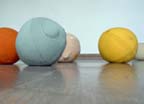
Tread Softly or Else
Dustbunnies, by Stijn Schiffeleers and Hendrik Leper from Boutique Vizique, is a colony of seven shapes that contain two kinds of sensors, a RF-communication system, two microcontrollers, a big battery, speakers and a motor. When there's no human around, they collect dust, hair, flakes of skin and dirt and murmur to each other in a mysterious language. But if you walk into their territory, they become quiet and pretend to be dead.
The only way to observe them in that first state is to be motionless yourself. Touching a dustbunny will cause different reactions. If they like the way you treat them they will make an amusing sound according to the movement you cause. But the Dustbunnies can also become angry. If you mistreat one of them, all dustbunnies will start screaming. The whole group will show their dislike.
For those interested in dirt and art, the dustbunnies will be at the UCI Beal Center (University of California, Irvine) from Oct. 4 till Dec. 10. [blogged by Regine on we-make-money-not]
Posted by jo at 08:25 AM | Comments (0)
September 07, 2005
Sonification/Listening Up:
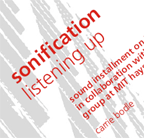
Research Made Audible
Sonification/Listening Up--by Carrie Bodle in collaboration with MIT Haystack Observatory--is a multi-speaker site-specific sound installation on I.M. Pei's iconic Building 54 at MIT. The speakers broadcast audio representations of sound waves embedded in the Earth's charged upper atmosphere, or ionosphere, a region under active radar study by the Atmospheric Sciences Group at MIT's Haystack Observatory. This project utilizes sound as a representation of research at MIT, extending to the public what is normally invisible.
The speaker arrangement on the Building 54's façade recalls an downwards-sloping graph. This is representative of the spectral frequency distribution of the sounds, which vary both by time and in altitude. The broadcast sounds are in fact frequency-scaled versions of ion-acoustic pressure waves within the hot ionospheric gas, which changes state in a complex interaction with the Sun's varying output. Seven different altitude levels in the ionosphere have been used to construct ion-acoustic sounds that will broadcast from seven layers of speakers on the facade of the building.
Time: Daily 12:00-1:00 pm
Dates: Sept 9-16 2005
Location: South facade Building 54, MIT campus [map]
Sound Off (closing event): Sept 16th 5-7 pm
Sonification / Listening Up is done in collaboration with Dr. Phil Erickson of the Atmospheric Sciences Division at MIT Haystack Observatory. Sponsored by the National Science Foundation, MIT Haystack is currently the only observatory located in the Continental United States that uses this powerful ground-based sensing technique to map changes in the makeup of the ionosphere. Such changes, especially during disturbed periods, can affect the precision of GPS technology and other man-made long distance and satellite transmissions. Knowing and predicting the constitution of the ionosphere has become an integral goal for commercial interests as well as a driver of the national Space Weather effort funded by the National Science Foundation, and this project puts a spotlight on nearly five decades of study by the Haystack research group at MIT.
Funded by: MIT Office of the Provost , MIT Vice President for Research and Associate Provost, MIT Associate Provost for the Arts, MIT Department of Architecture, MIT Visual Arts Program, and Council for the Arts at MIT.
Posted by jo at 01:41 PM | Comments (0)
September 06, 2005
Ars Electronica
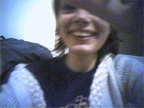
Regine Blogs Ars
TEMPEST is based on the surveillance technology known as Van Eck Phreaking - computer screen content can be reconstructed remotely by picking up the emitted EM-field of the screen. TEMPEST utilizes this technique to transform purely generative graphic into a composition of noise which again is fed back into the image generating process. Several AM receivers are tuned into different frequencies of a screen and plugged into an audio mixer for further sound processing. The graphics on the screen become a means of producing sound and it is only the graphics which determine the different timbres and rhythms. By Erich Berger.
Interface Culture at the Linz University of Art was founded last year by Christa Sommerer and Laurent Mignonneau. The programme deals with human-machine interaction to develop innovative interfaces. Went to see their works yesterday.
SoundToy, by Christina Heidecker, Harald Moser and Timm Oliver Wilks, is a 3D environment you navigate as if you were a racing car driver. During the ride you use the steering wheel to create and compose 3D sounds. You place in the space sound objects assigned to electronic beats. The speed, pitch and volume can be individually adjusted using the steering wheel and the accelerating pedal. The composition is generated by the movement and position of the sound objects with respect to one another but also by the route you select.
Recipe Table, by Istvan Lorincz, Hanna Perner-Wilson, Thomas Wagner and Andreas Zingerle, is an interactive workplace built into a kitchen countertop that enable users to intuitively search for recipes. You place the tins and bottle, vegetable and other ingredients and in return the system makes you recipe suggestions. These culinary suggestions are also depicted graphically as finished dishes on the workplace.
Blow, by Taife Smetschka, is a breath-controlled video installation. There's a microphone and a projection of a clip from Billy Wilder’s film *The Seven Year Itch*, the scene in which Marilyn Monroe stands on the grate above the subway ventilation shaft. At first she is stationary, smiling at viewers from the screen. She doesn’t begin moving until she feels a cool breeze. In *blow!* the breeze has to be provided by the installation visitors who must blow as hard as they can into the microphone. Marilyn’s skirt flutters in the breeze as long as the visitor blows into the microphone.
Mika Satomi's Gutsie is a cyber android filled with “guts.” Peeping into its interior through its eye-like hole, you can observe its intestines in motion. It will show you the places you want to see by tracking your eye gaze, but at the same time, your gaze may infect it. The interior of our body is something very private, often disgusting, and thus prohibited to be seen or to be shown. In media, visual images of our insides are often used to induce feelings of violence or disgust. Ironically, this is something that is stuffed inside everyone’s body without exception.
The G-Player (Global player), by German artist Jens Brand, works like a CD-player. But instead of playing CDs, it plays the globe. The device knows the postion of more than a thousand satellites and enables you, by the use if a virtual 3D planetary model, to listen to an imaginary trace of a selected flying object. Like a needle on a record, the satellite follows the Earth's surface. The G-Player transforms the different elevations units course directly into sound. The simple display shows the selected satellite's name, type, altitude and position over the planet (thus the latitude and longitude). Topographic data are interpreted as audio data. "Noise sounds" result from the high density of the data. Pictures.
[via we-make-money-not]
Posted by jo at 08:45 AM | Comments (0)
August 31, 2005
Plug
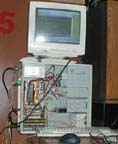
Global Headphone Festival
[Though it looks to be quite dysfunctional, this sucker sends the streaming Plug signal around the globe [Photo: Keith Axline].] "...In some ways Plug, held here Saturday, is just what you'd expect from a music fest: rotating performances in front of a live audience, socializing and plenty of beer. But the headphones (bring your own) replace a traditional concert's amplified speakers, and much of the socializing happens over a computer terminal linked to an IRC chat room, populated by members of the global audience listening to the performances over the internet...
The 13 hours of performances represented San Francisco's turn at the global le placard headphone festival, which hits cities all over the world, including London, Montreal, Paris, Brussels and Nagoya, Japan. Each city hosts a headphone party for a given period, in this case one day, before handing off the feed to the next location. Theoretically, this continues for 97 days in the hopes of providing one nonstop experience, though there are gaps in the schedule." From Fest Rocks With BYO Headphones by Keith Axline, Wired.
Posted by jo at 11:40 AM | Comments (0)
Repercussion.org

Virtual Instruments for Live Performance
Repercussion.org is a collection of on-screen virtual instruments designed for live performance and online user exploration. Rhythms and musical phrases can be dynamically composed and altered based on the arrangement of objects on the screen.
The collection is a showcase for the visual representation of freely-formed musical compositions. The project aims to be engaging enough to encourage the viewer to experiment, while being sophisticated enough to allow for a great deal of variation in the sound being created. The actual musical compositions are generated in real-time from a library of pre-recorded midi-based sounds, employing algorithms to map the on-screen graphics to characteristics of the sound arrangement such as pitch, tempo and volume.
The graphics were designed with a wide audience in mind, such that the concepts represented are accessible to a viewer regardless of his level of musical training, while at the same time matching the artist's idea of a basic kit of musical instruments for “jamming”: some drums, some melodies, a way to create chords, strings, etc. To be available to the largest online audience, Macromedia Flash was chosen as the medium. The piece is a work in progress that will be updated and customized. [blogged on media·teletipos]
Posted by jo at 11:19 AM | Comments (0)
Pink Noise
Urban Noise Pollution Displayed on Street Advertising Boards
Pink Noise by arts collective HeHe.org will be installed in Witte de Withstraat, Rotterdam on Sept. 10th, during the live event Hands On Hands Off organised by V2. Bruit rose (Pink noise in English): The interaction of this work is based on visualising the ambient sounds in the environment aswel as the passerby. The light emmitting panels, usually used to divulge numerically formatted information, are instead détourné from this didatic function and serve as an animated visual, disengaged from all the gloss that usually occupies this urban advertising space. [via URBAN SCREENS 05]
Posted by jo at 10:47 AM | Comments (0)
August 27, 2005
wave_scan

Allegorical Mapping of the Liminal
wave_scan, by Brad Todd, is composed of an ELF (extremely low frequency) sensor, an antenna and a projection of a video database of water filmed over the past 15 years in different countries.
The system is centred around the ELF sensor. In paranormal research these electric and magnetic fields are also monitored by people searching for ghosts and other inexplicable phenomena: "cold spots" and other signs of paranormal activity reported by persons who think they are seeing phantoms are in fact closely tied to these EMF fields.
The ELF sensor is attached to an old TV antenna and is transmitting to a computer. Any detection of weak fluctuations of frequencies near the antenna results in the direct manipulation of a soundscape which is generated using a sine wave and white noise to create synthetic oceanic sounds. Any readings are also translated as clicks and pops, thereby creating a minimialist audio environment which gives audible evidence of a "presence" in the space.
Besides, the image slowly works itself from full chroma to blank, depending on the number of "hits" in the space. This sense of effacing the work and rendering the image into a ghostly and finally invisible screen closes a circuit or cycle of the works "life", in an allegorical mapping of our anxiety concerning the unseen or liminal... [blogged by Regine on we-make-money-not]
Posted by jo at 09:15 AM | Comments (0)
August 25, 2005
StarChild + FlatWorld

Data Sonification
Data sonification has been viewed as a tool with great potential for studying complex sets of scientific data. Sonification can provide the researcher with the ability to perceive variations and trends that are invisible to more established data analysis techniques. However, few have explored the potential artistic applications of sonification. In 1996, Jarrell Pair worked with Alec Robinson to se Matlab and Csound to prototype software to transduce data from various sources such as images, temperature, and light intensity into aesthetically pleasing audio. We used this work to develop the audio effects for StarChild. Using Csound and a custom C program, astronomical data from the Shoemaker Levy-9 comet collision was used as input to create audio for portions of StarChild. Additionally, images of the collisions with Jupiter were transduced into audio effects using Hyperupic, an application running on a NeXT computer. 440k MP3 file (low sample rate) taken from the sample files created from the comet collision.
From July 1995 through June 1996, Pair was extensively involved in the technical development of StarChild, a multimedia opera. The opera was composed and produced by Audio Research Team director, James Oliverio. Alec Robinson and Pair created sound effects for the opera using data sonification methods we had developed as part of an ongoing team project. He was also involved in the installation, testing and evaluation of the eight channel audio steering system used in the opera.
The StarChild production team included visual futurist Syd Mead (designer for the films Blade Runner, Aliens, Tron, and Star Trek: The Motion Picture ), the internationally recognized lighting designer Lloyd Sobel, animator Steve Walker, and scientists and engineers from across the Georgia Tech Campus. Students met and worked with the guest artists in workshops, lectures, and in the production of the opera itself. An internet MBone broadcast of StarChild took place on June 5th, 1996. Two live performances followed on June 6th and 7th.

FlatWorld: The Mixed Reality Simulation Space
Since 2001, Pair has overseen the design and development of the FlatWorld project at the University of Southern California's Institute for Creative Technologies (ICT).
FlatWorld is a mixed reality simulation environment merging cinematic stagecraft techniques with immersive media technology. Current virtual environments have severe limitations that have restricted their use. For example, users are often required to wear bulky head mounted displays that restrict a person’s freedom to physically move as they would in the real world. Furthermore, a person cannot touch or feel objects in the virtual world.
This project addresses these issues by developing an approach to virtual reality simulation which allows individuals to walk and run freely among simulated rooms, buildings, and streets.
Posted by jo at 10:33 AM | Comments (0)
August 24, 2005
Appendix2
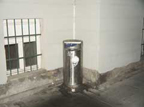
Activated by Passers-by
Appendix2--by Tanja Vujinovic and Zvonka Simcic--features an alternative state of urban landscape. The multimedia exhibition consists of short video works and interactive, computer based works displayed in the Kresija Gallery (Ljubljana, Slovenia) and interventions in the soundscape of the center of Ljubljana.
Small scale mechanisms (automata), made of sensors react to movement and small broadcasting units are hidden at several locations in the center of the city. Sounds are activated by passers-by and intervene into the structure of the town soundscape.
The sensors are attached to the garbage bins and passers-by are then blessed with sounds of Chinese market and rickshaw drivers, laundry machine and parody ads for perfume. Well, I should write "the sensors WERE atached" as they've just been stolen. Fortunately, the rest of the exhibition is still up and running till August 28. [blogged by Regine on we-make-money-not]
Posted by jo at 10:30 AM | Comments (0)
August 19, 2005
A Measure of Anacoustic Reason
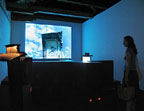
Turning a Deaf Ear
A Measure of Anacoustic Reason--by Raqs Media Collective--is an installation that registers a process of thinking about forms of reasoning that insulate themselves from listening. The installation sees the act of 'turning a deaf ear', as the unwillingness or inability to listen to the voices that refuse to be accommodated into the master narratives of progress, of instrumental reason and the domestication of space through the geomancy of corporations and nation-states. The visitor is invited to undertake his/her own audit of anacoustic reasoning through a meditation on a series of dialogues and rebuses that encrypt a set of paradoxes about the grandiose follies of seeking to rule the world by not listening to it.
A Measure of Anacoustic Reason is an installation consisitng of 1 projector, 4 screens, 4 dialogues, 4 lecterns and a lightbox. It was shown at ICon: India Contemporary at Venice Biennale 2005 (14 June-31 July, 2005)
Raqs Media Collective is produced at the Sarai Media Lab, Delhi and
at Montalvo Arts Center, Saratoga.
Additional Credits
Sound Editing: Iram Ghufran
Print Design: Mrityunjay Chatterjee
Production: Ashish Mahajan
For images of the installation please see
http://www.raqsmediacollective.net/anacoustic.html
http://www.universes-in-universe.de/car/venezia/bien51/eng/ind/img-
02.htm
Posted by jo at 09:02 AM | Comments (0)
August 12, 2005
HINGES ON
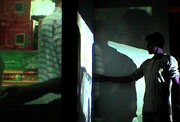
Adaptation, Access, Regulation, Open Source
HINGES ON is an interactive film installation on the informal and formal economies of India's "ICT capital", Bangalore. Visitors enter through a sparsly lit sound tunnel, where they are exposed to an audio experience of failed efforts to retrieve information. (The sound works can be downloaded from the site.) Finally, one is released into the room hosting the video installation. Multiple door-shaped screens in the centre of the space serve as projection surfaces for the four simultanous projections. The screens are on hinges and invite the visitors to turn them into the angel required to catch the projection they wish to watch. (You can find information on the themes and issues in the backdrop section). A switch board provides the interface to the speakers featured on video. (In depth documentation of the process including a list of interviewees and the 'making of switch board, doors and software patches is accessible here!'
HINGES ON at Ars Electronica, opening September 1, 2005, 15:30, Campus / Kunstuniversität Linz. The work was realized by ambientTV.NET during the Tactical Media Lab at Srishti School of Art, Design and Technology, Bangalore, India; with Thomas Abraham, Salam Hidish Singh, Ishan Ghosh, Nishita Kavadia, Siddharth Muthyala, K.T.Thomas, Pratima Kalmadi, Divya Viswanathan, Umang Razdan Bhattacharrya, Ramyah Gowrishankar, and Priyanka Dilip. Lab led by Manu Luksch and Mukul Patel.
Posted by jo at 09:19 AM | Comments (0)
August 05, 2005
Printball
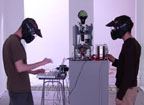
Recyclism, aka Benjamin Gaulon
"I urge you all to go and check out the work of Recyclism, aka Benjamin Gaulon, fantastic stuff. Here are two projects that I want to post separately. The first is Printball. Imagine an inkjet printer, but instead use a paintball gun and shoot dots at a wall to print the image. Created using Max/MSP and an Atmel board. There is a good 32mb mpeg4 to download (in the projects section). I (also) introduce you to The Res® (Recycling Entertainment System). 6 NES controllers, midi signals and Max/MSP allow players to jam together. There are 4 videos in the project section of the Recyclism site. [via]. Digital Recycling was Spotlighted on Turbulence in 2004.
Posted by jo at 08:58 AM | Comments (0)
August 01, 2005
Ruccas.org
![]()
As Good as the Community Makes It
Today, Ruccas.org celebrates the end of its first year of operation, and the start of the next. A year ago, ruccas.org launched with a handful of artists. Today, it features the works of over seventy artists and collaborative projects, nearly all of which are available under a Creative Commons license.
Its growth and success are due entirely to the community, who have taken advantage of how easy it is to add their own page and share their work with one of the largest online audiences for unconventional electronic art. Ruccas.org's allowing of anyone to edit the site and add their own pages, as well as its offering of free hosting for aural, visual, and software art, has enabled this to happen. The ruccas.org philosophy is that the best way to create a site of this type is to give the community as much control as possible, and artists from all around the world have stepped up and proven that our philosophy is correct.
In the coming year, I personally hope that the site will continue to grow at the rapid rate it has been. Ruccas.org is a unique hub in the sense that is it only as good as the community makes it. Therefore, I urge all of you out there who are are trying to do something "new" to come share your artwork with us, and to encourage others to do the same. I know that I speak for the entire ruccas.org community when I say that we're looking forward to the next year of new additions, new directions for the site, and new community members.
- John Nowak, Ruccas.org
Posted by jo at 08:20 AM | Comments (0)
Exploration of TIME + Delay Phone
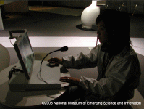
Delay as a New Communication Style
The Exploration of TIME exhibition poses the question "(i)s it "time" that produced humans, or is it humans that created "time"? "Humans are inseparably bound up with "time." Time assumes diverse, multi-layered forms in the world ranging from the micro- and macro-world of science such as the universe, living organisms, life, and materials, to the world of cultural representations such as Our explorations and experiences in a new world of time will certainly provide us with a hint for humans' future lifestyle or ways to deepen our thinking."
Delay Phone, by Ryota Kuwakubo, is a video phone system that allows users to intentionally increase or decrease the delay in audio communication. This system is designed to experience how subtle changes of the delay in audio communication may affect our inter-personal communication. It may also allow users to see how new communication styles may emerge with a certain amount of delay.
One of Kawakubo's major interests is in how technologies may change the way people communicate. R/V and PLX clearly reflect his interests in this area. Even, a knocking machine Duper/Looper is inspired by the way we communicate in a specific context: bathrooms. Imagine a machine like this inside a bathroom, which knocks back the door copying exactly the way you knocked…Related websites: vector::scan and Time Travel Exibition at YCAM (in Japanese) [blogged by manekineko on we-make-money-not]
Posted by jo at 08:03 AM | Comments (0)
July 25, 2005
Radio Forest
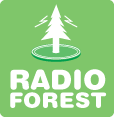
Sonic Wanders
The content on Radio Forest is made up of music and sound donated from the people of Neerpelt and surrounding areas, including; LP’s from personal collections, stories, lore, and sound produced during workshops at Musica. Portable radio’s will be available to check out at the Radio Forest cabin so that visitors can have a sonic wander through the forest.” The project is commissioned by Musica in Neerpelt, Belgium and a collaboration between artists Stijn Schiffeleers and Amy Franceschini as a sound project in reaction to this space."Upon their first visit to Music in December 2004, Amy and Stijn’s first impression was the roaring sound coming from the freeway passing through the forest. It was such a dominant sound factor, that they proposed to broadcast forest sounds from within the forest to the cars passing by on the freeway.” So driving by the forest will let you tune into forest sounds and avoid the technological distraction of your engine’s hum. [blogged by Jonah on coin-op]
Posted by jo at 10:02 AM | Comments (0)
July 22, 2005
Golden Numbers
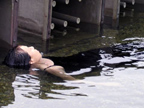
with Red Symbol
Golden Numbers--by Park Lee Chang Shik--is a sound installation that uses the gigantic speakers that were formerly used at the DMZ (demilitarized zone on the border between North and South Korea) for broadcasting propaganda. In this installation, the numbers from 0 to 36525 are read out. This number represents the number of days in the hundred years from August 15, 1945 to August 15, 2045. Further, recordings of old radio broadcasts and sounds produced in real-time from encoded signals are heard intermittently, and the audience can also use a microphone to broadcast their own voices through the speakers.
All these sounds mingle slowly around a circle, resembling the movement of a clock's hand or the orbit of a celestial body, and allude to the passage of time and history. The voices recorded into the microphone show that everyone lives within the flow of time, and contributes to history in some way. [via]
Posted by jo at 09:44 AM | Comments (0)
July 07, 2005
Sleeping Dogs Lie - Part 2 - untitled

Navigable Cinema
Sleep and Insomnia. Alcohol. Drugs. Crime. Love making. Rock 'n' Roll. Memories. Distances seem to change. In the night, one's thoughts go from city to city, from one place to another, dreaming of another life in each other's place.
e-Xplo will create and present four performances of Sleeping Dogs Lie, a specially commissioned audio coach tour of nocturnal NewcastleGateshead in a coach equipped with an audio system and GPS receiver. The performance combines pre-recorded and live electro-acoustic sound, transforming the ordinary coach into a navigable cinema.
We cannot escape the politics of the sites we choose, and even in mapping a tour, even in struggling for the visual element, we cannot avoid the specifics of the place entirely. Having said that, how may our concerns be heightened by the visual, historical, architectural, acoustic and political circumstances of Newcastle? The night challenges us to enter a process of constructing and reconstructing topographical views on the subject.
e-Xplo develops maps, routes, sound and film materials as reflections of a multifaceted investigation into location, context, social identity, landscape, and the public space of information.
Each work proposes distinct but related topics, thus focusing on specific issues for concrete places while searching for broader insights.
e-Xplo is the framework for the collaboration between Erin McGonigle, Heimo Lattner, and Rene Gabri. Since 2001 they have organized bus tours in Budapest, Massachussetts, Berlin, London, Eindhoven/Rotterdam, Turin, and New York. [via net art review]
Posted by jo at 10:43 AM | Comments (0)
June 28, 2005
Step + Repeat: Pittsburgh Cycle
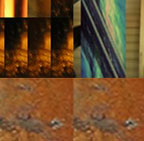
Shifting Technologies and Economies
Step + Repeat: Pittsburgh Cycle--by Carlos Rosas and Robert Dansby--Call for Participation: Submit your images of Pittsburgh. Your images will be entered into the image database and be included in the participatory tile sequence projected in the Palmer Museum and viewable on the Internet via live webcast. For more information on this project, to submit images and to view the live broadcast visit the project web site.
Abstract: A live audio and video based piece using networked media. Based on digital “step and repeat” cycles: a loose metaphor, the Pittsburgh iteration uses video and audio samples recorded in Pittsburgh, PA, and the surrounding western Pennsylvania area –with touchpoints including Primanti’s, the Strip, the Southside, East Liberty, the Northside, Beaver Falls, Jones & McLaughlin, the Monongahela Incline and Pittsburgh’s three rivers.
Divided into into six primary segments and a seventh segment including material contributed by viewers to be filtered through a digital randomizer, step and repeat: Pittsburgh cycle maps entrance into an urban environment via incline railway, transit through the city, reflections of the community’s industrial past, particularly steel, and the transformation of city and countryside as the industrial economic base shifts and nature again takes hold of old worksites. In the last two segments the viewer leaves the city, again on incline railway, and watches as the evening paints the city as a visually appealing study of water and reflection.
Concept and Development:
With a nod toward Allen Sekula’s work: specifically “Fish Story.” This piece chronicles (in a documentary fashion) the ironies, displacements, shifting values, economies and systems: the transformation of an American city as an industrial and economic center shifting from steel to telecom, and the reclamation of areas of the city and countryside dedicated to old economies/technology by both nature and the population at large - a population with new needs but retaining a core identity.
The “Step and Repeat” cycles are variable and highly dynamic works performed live with laptops or in automated modules prepared for web or installation on site. The media resources are mixed, filtered, and emitted via live performance software…deriving image, video, qtvr, audio, and net streams from databases and databanks resident on local and networked laptops and servers.
Posted by jo at 12:21 PM | Comments (0)
June 16, 2005
Janet Cardiff
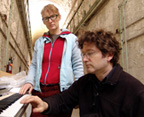
Invisible Architectures
"For the second consecutive summer, Janet Cardiff’s celebrated audio tour Her Long Black Hair is being presented by the Public Art Fund in Central Park. But this isn’t Cardiff’s only summer engagement on the East Coast. The percussive sound installation Pandemonium, made collaboratively with her partner George Bures Miller, is at the Eastern State Penitentiary in Philadelphia until November 1. Here, art critic and historian Megan Heuer discusses Cardiff’s use of sound to examine the phenomenology of social settings.
Since the 1980s, Janet Cardiff has made art that employs sound as a physical material. In the elaborate installation The Dark Pool, (1995) sounds are located within an enigmatic, cluttered study and shift according to where one stands. Her binaural audio walks use her own recorded whispering to direct the participant’s movement through a landscape. Much of Cardiff’s work explores the nature of subjectivity within the highly mediated universe of contemporary culture, questioning the boundaries between fact and fiction, reality and memory or fantasy..." Continue reading Invisible Architectures by Megan Heuer, NYFA Current.
Posted by jo at 07:44 AM | Comments (0)
June 07, 2005
Interfacing/Radiotopia/KeyWorx
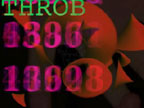
Translocal Exchanges
Interfacing/Radiotopia/KeyWorx consists of one space that has no images and has only sound, and one space that has no sound and only images. They are connected both physically and via the Internet.
SPACE 1: [Radiotopia] Walk into a theatre and enter an audio space with no images. Artists from all over the world are asked to send in audio material to fill up a database. Behind every sound is an idea, a world of words and definitions. The one big experience with Radiotopia is the peaceful confrontation of all the world's sounds, audio artists, concepts, sights and sometimes ideologies. In the Scapino theatre, the sound is mixed live by musicians and resent as an audio stream.
SPACE 2: [KeyWorx] Walk out of the theatre, down a narrow hallway and enter a space filled with images. Three artists sitting in the space, are connected with three artists in New York City. Three translocally linked pairs, three simultaneous and connected performances.
Behind every sound is an idea, a world of words and definitions. In the KeyWorx space, one listens to the world of words within the audio–spoken words, ideas, emotions, memories–and translates that world into actual text.
Inspired by a Surrealist game 'Parallel Stories', a word sent by performer or public from a mobile phone in response to the audio appears simultaneously in all three performances. Each performance pair responds to this foreign text input sent via 'sms' by creating a visual story around it. Three parallel translocal exchanges within one physical space (a room in New York, the V2 bookstore) are connected by the same word yet are unique in the visual interpretation of it. The performance is improvised and created collaboratively in real-time.
These compositions are projected onto the screens throughout the V2 space.
Want to know how we put this performance together? Follow the process log.
Credits: Concept KeyWorx Space: Isabelle Jenniches and Michelle Teran with Sher Doruff • KeyWorx performers: Isabelle Jenniches, Arjen Keesmaat, Lodewijk Loos, Eric Redlinger, Michelle Teran, Dan Vatsky
• Radiotopia project created by: Rupert Huber, August Black and Norbert Math KeyWprx project created by: Waag Society for Old and New Media.
Posted by jo at 11:57 AM | Comments (0)
June 02, 2005
( ( ( N O M U S I C ) ) ) A R E N A I I

Open Call to Net Audio Players
-< 48 Players on Dual Play >-< 24h Continuous Net Audio Festival >-< Audio Live Performing only via Internet >-< Creative Commons Audio License - No Archivz >-< Stream Live Audio/Low & High >-
Stream Start: October 12 (00h00/00:00am); Stream End: October 12, 2005 (23h59/11:59pm) [GMT+0 Greenwich Time]. Join Now the ( ( ( N O M U S I C ) ) ) Deadline: September 21; Final playlist: September 28, 2005
(((NOMUSIC))) is a free platform for audio diffusion via Internet dedicated to Players. Interventions come from two simultaneous countries and follow each other in a regular manner at the rate of two peoples per hour. The development of this Network is aimed at promoting experimentation and creation.
The contributions are disseminated from different countries with two simutlaneous participants being allocated one hour in sequence, dispatched on the channel left for the Player 1 and the channel right for the Player2 , re-creating a unique stream and stereo.
(((NOMUSIC))) co-ordinates the interface for these different geographical point without any interruption, moving the audience during 24 hours from one country to the other, without jet-lag. No audio data is kept, the aim being to favour live performance throught the different stream technique in simple, multi or co-stream. The axis of development is not to constitute one dead data basis on hard disk, but to be determinedly a movement on the web where each author becomes an available data and a geophysical site that constitutes a visible tie thus during one terrestrial complete revolution foxglove.
Posted by jo at 07:18 AM | Comments (0)
June 01, 2005
whiSpiral
![snow2.small[1].jpg](http://www.turbulence.org/blog/images/snow2.small[1].jpg)
Embedded Memories
whiSpiral is a spiral-shaped shawl that carries whispers of your loved ones and explores how technology can enhance the way garments and accessories evoke memories of these relationships. Circuitry integrated in the textile allows your friends to record audio messages at different points in a spiral-shaped shawl. These messages are whispered back each time you wrap the shawl around yourself, or by caressing different parts of the fabric.
Each of the 9 miniature audio recording modulescan store a 10 second message. The locations of the modules are made visible by exposing some of their electronic components on the exterior of the shawl, covered by a protective material resembling 3 white leaves. A microphone connector is denoted by a yellow leaf. The whispers are released when sensors located in each audio module detect a soft caress or wrapping movement. Developed by Elena Corchero and Stefan Agamanolis when working for the Human Connectedness Group at Media Lab Europe. [blogged by Regine on near near future]
Posted by jo at 07:01 AM | Comments (0)
May 31, 2005
SHARE

Hosting Open Jams Every Sunday
SHARE Audio Jam: Prepared and spontaneous music from eight plus simultaneous performers. This is the time and place to perform a piece of music you've written and hear it on a large sound system, improvise spontaneously with other participants, get feedback on your latest project or try out that new max patch/software setup. Bring your noise maker of choice and an XLR, quarter-inch or RCA cable to join.
SHARE Video Jam: multi-user live video synthesis. Generating an immersive visual environment, in the SHARE tradition, in which multiple participants are able to jointly compose the video output. Try out and learn about new VJ wetware. As with the audio, walk-in sets are encouraged. Bring your clips or camera or laptop/amiga and VGA, S-Video, or RCA cables to join.
Share.mobile events happen in the context of teaming up with other venues and festivals to create a forum for large scale audio/visual jams.
With these forums we seek to encourage artistic expression and promote cooperation within communities. Modern Society often pits us against each other, stifling expression and the realisation of a healthy, sustainable existence. If people can express themselves loud and clear, 'Share' believes, a workable concensus is attainable. By going mobile we bring an example of this philosophy, played out to a new audience and that audience is participatory.
SHARE @ Club Transmediale 004
Berlin - February 2 + 3 + 4, 2004
SHARE @ PixelACHE
Montreal - June 6, 2003
SHARE @ eLECTRONIC xTRAVAGANZA
the Kitchen, New York - March 14 + 15, 2003
SHARE @ Transfert Festival
Zoobizarre, Bordeaux - Spring, 2003
SHARE is a community for portable performers, founded in 2001 by Barry Manalog, geoffGDAM and Newclueless, that provides an open forum, in real life, for data exchange and media performance. Every week we host a free multimedia jam open to all participants and observers. Walk-ins welcome.
We are the place to: preview that video project you're working on, learn about new software developments, sing a new pop song you've written, join an open jam of digital artists, form an impromptu collaboration, hear how your new songs sound on a big system, meet co-conspirators for art projects, spin some mp3s, look for new Max patches and Buzz machines, or relax and have a sunday drink with interesting people.
Posted by jo at 11:56 AM | Comments (0)
Audio x 3
![audiograffiti[1].jpg](http://www.turbulence.org/blog/images/audiograffiti[1].jpg)
Audio Messages Left in Space
Theodore Watson's Audio Space allows you to leave messages in specific locations within the room. Wearing a headset equipped with earphones and a microphone, visitors record messages that are then placed in the spot where it was recorded. Through the earphones, the messages are played along with those recorded by previous visitors. Each message sounds as if it is coming from the spot where it was recorded. The resulting effect is the sensation of walking through a space inhabited by ghosts, with each visitor leaving an aural mark for others to uncover. Video (wear headphones!) This work is part of the Parsons Thesis Show 2005.
Audiograffiti, by Andreea Chelaru, Ben Dove, Noel Perlas and Thomas Stovicek, investigates the "space with an audio memory" idea as well. The system allows you to leave tracks behind you through an "audio imprint", just by going into an inflatable fabric tunnel, and activating one of the microphones that are ready to record and broadcast whatever we like, in a sort of melodic loop. More info: 1 and 2.
With Audiotag, by Lalya Gaye and Margot Jacobs, from the Interactive Institute in Sweden, previously recorded personal messages are left at hidden places in public spaces to be whispered to passersby as they lean towards small boxes fixed in urban environment (blogged last year.) See also: Siemens' electronic Post-It (via textually.) [blogged by Regine on near near future]
Posted by jo at 07:31 AM | Comments (0)
May 30, 2005
ResonanCITY
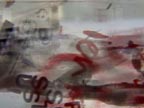
Live Audiovisual Performance
Many sounds and images in our everyday lives slip past our notice simply because they are too small, or because we lack the proper receivers to pick them up. ResonanCITY is an ongoing project to gather these microscopic sounds from various cities, and to amplify and transform them. The goal is to build a new city of sound and visuals inside the old one, and to inspire curiosity and exploration of one's own environment. Video artist Sara Kolster, searches for details and objects which she transformed in a microscopic way into macro-images. She uses different macro-lenses and a lightbox, capturing and manipulating these images live, without the use of any filters. The combination of film- and video techniques with analogue tools as found footage, positive film and photographs gives the performance a layered character.
The sound of resonanCITY is based on gathering elements which are specific to each location and reinterpreting them in a performance setting. Field recordings, found objects, folk music and spoken texts are mixed and processed live with the computer with the intention of uncovering hidden details and nuances that escape everyday perception. For some performances, the audience is encouraged to bring objects which they think might become interesting if listened to more carefully, and an improvisation is based on these objects. Quicktime movie.
Posted by jo at 12:29 PM | Comments (0)
May 27, 2005
ætherspace
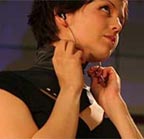
Hertzian Space Made Audible
ætherspace--by Nick Knouf--is a computational garment that uses transducers of electro-magnetic waves to make hertzian space audible, make the invisible sonic, giving the wearer a better understanding of the electronically-embodied world.
Transducers pick up the various components of hertzian space as you walk around. These components feed to a scaling algorithm that brings the range of hertzian space to that of normal hearing and can be perceived through the headphones. The project raises questions such as: What does a cell phone sound like when it is idle in a bag? What do dangerous EM waves sound like? Should the scaling algorithm take into account the perceived danger of certain types of EM radiation, e.g., make gamma waves a high-pitched screeching noise? If so, how would this change our interaction with space? Related: Electroprobes, the Amazing All-Band Radio, and Urban Chameleon. [blogged by Regine on near near future]
Posted by jo at 10:00 AM | Comments (0)
May 25, 2005
FLOAT
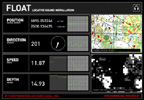
Listening to Place
In FLOAT--by Tuomo Tammenpää and Tamas Szakal--the ship is the play-head and the route is the track. Depth, direction, speed and surrounding islands build the score of the sound installation. The ship plays the track as it moves across the Baltic Sea. On the surface, there are shapes of islands and the coastline, drawn on the sea. The multitude of ship routes and passages that connect countries and cities together weave a vast invisible network of paths.
The sea, especially the deep unknown, holds its mysterious nature in the era of extreme traveling. There is a fascination for the dimensions of waterbodies and the secrets it possesses. The power of a storm, the long horizon and the incomprehensible raises respect among most of us.
Crossing the various locations, the voyage, provides a lots of information, which can't be seen or heard. Taking a ferry on the Baltic Sea is usually just transportation or entertainment on board. In both cases, the sea itself is insignificant. This sound installation makes some of the invisible dimensions and the silent layers of data, audible. The ferry travels through a map moving high above the bottom of the sea floor, sometimes shallow, sometimes deep. The passage in time generates various data. All these data streams: the GPS coordinates, distance to islands, depth, direction and speed are translated to sounds. The result is a slowly developing soundscape that invites the traveler to listen to the place in time. [originally posted by inf* from information aesthetics, ReBlogged by marisa on eyebeam reblog]
Posted by jo at 10:44 AM | Comments (0)
May 22, 2005
Voice Mosaic
![]()
Turbulence Spotlight
Voice Mosaic--Martha Carrer Cruz Gabriel--is a web-art application that converges speech and image, building a visual mosaic on the web with the chosen colors and recorded voices of people who interact with it from any place around the globe. The voice interface, developed with open-standards in speech synthesis and voice recognition technologies, works through phone calls from any telephone.
Martha Carrer Cruz Gabriel is Director of Technology at NMD Internet & Multimedia, Ltd. - developers of several successful websites in Brazil, like HBO's, Sony's, and Warner Bros' television channels and Monica's Gang - winner of 9 Internet Best Awards in Brazil since 1998. She is Professor of 'New Technologies' and 'Marketing' at Universidade Anhembi Morumbi; International technical advisor in US for AllHealthNet.com; and a frequent speaker at Internet conferences in Brazil and the US. Engineer, postgraduate in Marketing and Graphics Design, she is currently pursuing her Master's degree in Multimedia at ECA/USP, focusing on man/machine interfaces.
For more Turbulence Spotlights, see >>
Posted by jo at 12:01 PM | Comments (0)
April 25, 2005
Itinerant

A Site-Specific Sound Installation in Boston Common
Itinerant--by Teri Rueb--is a site-specific sound installation in Boston, Massachusetts. It invites people to take a walk through Boston Common and surrounding neighborhoods to experience an interactive sound work that re-frames Mary Shelley's Frankenstein, the classic tale of conflict between techno-scientific hubris and the human spirit. The project engages a search for an elusive character who is doppleganger to both the doctor and the creature. Sounds, 'played' by visitors as they move through the city, create a series of frames within which to reflect upon our highly mobile, technologically saturated society and issues of identity, place, and displacement. Mobile and locational media (GPS) formally underscore themes in the work. The sonic overlay is also presented as an interactive map on the web, creating a formal re-framing and displacement of this site-specific work (needs Flash Player, headphones and broadband connection).
Equipment may be picked up through May 7, 2005 at the Judi Rotenberg Gallery, 130 Newbury Street, Boston. "Itinerant" is a 2005 commission of New Radio and Performing Arts, Inc. (aka Ether-Ore). It was made possible with funding from the Jerome Foundation and the LEF Foundation.
Posted by jo at 01:34 PM | Comments (0)
lifeClipper

The Walking Experience
lifeClipper is an open air art project. It offers an audiovisual walking experience in a virtually enhanced reality. Technically it is based on portable computer equipment worn by an individual. When walking around in a chosen culturally interesting area or impressive landscape the visitor's position and viewing direction is measured by means of GPS and the found situation augmented according to defined presets. Image and sound are displayed on an HMD (Head Mounted Display). Live captured image and sound are treated in real time by altering parameters as well as by adding music (composition, spoken text and sampling of documetary material), photo and video material (documentary and fictively arranged).
Through interventions on habitual ways of listening and seeing, reality becomes questioned and day-to-day situations become an adventure. Users feel as though they are watching a film in which they participate as active observers and in which they get attention from virtual players. The borders between subjective and objective perception become blurred as the user is immersed into space and action but also contemplates artistic compositions and cultural reflections. Read a review.
Posted by jo at 09:28 AM | Comments (0)
April 22, 2005
Footsteps of Hans Christian Andersen
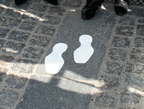
Footstep Hack
"A virtual discovery of Copenhagen in the footsteps of the famous author Hans Christian Andersen has been hacked, possibly by 'gay-activists'. Footsteps of Hans Christian Andersen - A Sound-Walk through the author's Copenhagen is a part of the Danish celebration of the 2005 HC Andersen bicentenary. The project invites people to follow in his footsteps and listen to audio narratives via their mobile phones at selected locations.
The route is marked with 2000 footsteps painted on the sidewalks - however, by adding a few extra footsteps it was diverted to the doorstep of local gay-clubs. The small hack might be a statement, rather than a prank. The HC Andersen anniversary has been criticized by the gay community for ignoring the author's homosexuality. E.g., a papercut by HC Andersen portraying two men holding hands inside a heart was used as a motif in a Christmas decoration by the fashionable department store Magasin du Nord - but instead of two men holding hands, the original artwork was 'corrected' to a woman and a man." See article (Danish) [blogged on guerrilla-innovation]
Posted by jo at 01:17 PM | Comments (0)
Sound as Multi-User-Choreography
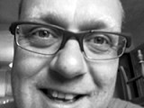
Steve Symons in Conversation with Sabine Breitsameter
"During the last months, the Manchester based artist Steve Symons has been presenting his interactive sound installation Aura in Europe and North America, on big public squares.
Aura is based on the Global Positioning System, which means that it relates sounds to the respective positions and movements of the environment's visitors. Each visitor has to wear a headset and a small rucksack on the back. By this, not only the individual sound-space relationship becomes audible, but also, the visitors are able to distinguish other installation's participants from the passers-by." Continue reading Sound as Multi-User-Choreography
Posted by jo at 09:55 AM | Comments (0)
April 20, 2005
9PIN

Mapping the SCAN Community
In summer 2003, a call for artists was sent out for the project 9PIN. The call asked artists to respond to the (then) 9 geographical locations occupied by the consortium members of SCAN. Proposals were submitted for a series of residencies and commissions looking at the possibilities for networking and mapping in the SCAN community. James Coupe, Hedley Roberts and Rob Saunders, Hywel Davies, Armin Medosch and Ivan Pope were chosen because of their range of inventive approaches to the SCAN network.
From Armin Medosch’s data visualisation research starting with a comparison between real and virtual ports through to Hywel Davies’ compilation of a sound database, gathered from each of the consortium venues, for the composition of new material by both himself and other musicians and composers, each of the artists involved in 9PIN makes a significant contribution to their own areas of practice and dissemination of content, whilst helping SCAN to cohere a very disparate group of organisations brought together by their desire to collaborate on high quality experimental work.
Ivan Pope brings his sketches and ideas using GPS, to enhance his interest in psychogeography, to his workshops, while James Coupe and Hedley Roberts take on the difficult task of examining and building an intelligent system which reflects activity (data drawn from sensors installed at SCAN’s member organisations) at each venue in the SCAN network.
The 9PIN project is premised on research and development and brings together artists and makers who are at the forefront of their field. This is a flagship project for SCAN and sets a precedent for the organisation’s aspiration to facilitate an environment for practitioners to develop their process outside of other areas of institutional research whilst working towards high quality outputs for the SCAN network.
SCAN is the innovative new media arts agency in the south of England. As a network of organisations, SCAN is committed to the delivery and facilitation of collaborative works.
"SCAN presents a unique model of networking across a number of diverse arts organisations in the south of England. We commissioned the 9PIN project to explore the network and build a model for SCAN as a whole. We invited artists with an interest in data analysis and mapping to produce a body of high quality work. They have come up with some extremely creative interpretations of the commonalities and differences across the organisations in the network"- Helen Sloan, Director of SCAN
The aim of 9PIN was that each artist should make a significant contribution to their own area of practice, whilst helping SCAN to make connections between the disparate group of organisations that constitute the SCAN network. 9PIN is a flagship project for SCAN and sets a precedent for the organisation’s aspiration to facilitate an environment for practitioners to develop their process outside of other areas of institutional research whilst providing high quality outputs for the SCAN network.
Posted by jo at 09:50 AM | Comments (0)
InterPlay: Loose Minds in a Box
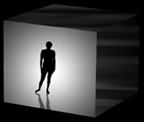
Six by Six
InterPlay: Loose Minds in a Box is a collaborative work that explores the basic concept of the "box". The box is a metaphor for the physical, social, political or psychological constraints that we and/or others place upon us. The box also represents a sense of place in the realm of the virtual as well as in our sub-conscience. InterPlay is a multi-faceted telematic event that consists of six simultaneous performances that occur in six states throughout North America. The performances incorporate theater, text, music, performance art, virtual reality, and motion capture and are concurrently captured, mixed, digitized, encoded and streamed onto the network.
Posted by jo at 08:42 AM | Comments (0)
April 19, 2005
Parking Public
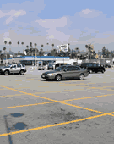
A Clash of Desires
With Parking Public, The Temporary Travel Office explores the largest openspaces around Hollywood Blvd, privately owned parking lots. The Travel Office is also interested in the relationships between the utopian spaces we all desire and the not-so-utopian spaces we end up inhabiting. This clash of desires and social realities is especially present in Hollywood, one of the centers of global utopian myth making. In order to bring these two worlds together, fantasy and reality, the Travel Office is distributing flyers on the windshields of parked cars soliciting answers to the question "what is your utopian destination?" By calling a phone number provided on the flyer, participants can leave a message describing their
dream locale, which is recorded on an audio blog. Because of the global network of influences on ideas of the utopian (those of us in the US often describe a tropical setting based on postcards and movies) as well as our material environment (the international distribution of goods and services), the survey is also open to people residing outside of Hollywood. The results of the survey are displayed on the web as they come in. A map of private parking lots and images from a walking tour are available on the site as well.
Posted by jo at 10:19 AM | Comments (0)
April 16, 2005
Global Pong
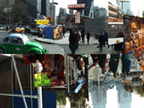
A Networked Babelogue Between Four Cities
Global Pong was a live dialogue on urbanism comparing local observations in New York City, Mexico City, Shanghai and Berlin, mediated through text fragments translated on-line into four languages. Texts were read live by a native speaker in its original language, cycled through four online translators projected as giant text banners, and then spoken again. Meanings shifted similar to a game of telephone ("teléfono descompuesto", "stille post"), and the four speakers added comments in their native language on each passing paragraph with keywords added into the translation cycle. Readers in this organic exchange of ideas included Vito Acconci, Andrés Oriard, Fu Xinian and Kai Vöckler.
Accompanying the texts were live video and sound components emanating from the four locations. Ralske created a visual interpretation/video collage from live webcam feeds. Composers in the four cities remotely contributed to a live ambient sound performance in which music files were passed along in an exquisite corpse style and "translated" similar to the textual work.
Posted by jo at 10:51 AM | Comments (0)
April 05, 2005
Audio Clouds

Body Talk
Building on previous work, researchers at the University of Glasgow have been developing Audio Clouds to control gadgets using movement and sound.
"The innovative aspect of this project is to explore a new paradigm for interacting with mobile computers, based 3D sound and gestures, to create interfaces that are powerful, usable and natural. The gesture modelling will be a novel combination of dynamic systems models and nonparametric statistical models. We will develop a wearable computer that uses 3D sound for output and head, hand and device gestures for input. This will allow us to investigate new presentation methods and interaction techniques to allow richer and more complex, tightly coupled interactions with mobile devices, opening up the possibilities for using mobile devices in a range of new ways." [via] [See 'Body Talk' Could Control Mobiles, BBC.]
Posted by jo at 08:59 AM | Comments (0)
April 04, 2005
TAXI MADRID
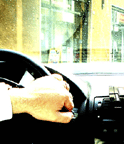
Another Taxi Installation
TAXI MADRID is a mobile public art intervention by artists Anne Lorenz & Rebekka Reich addressing issues of perception and the logic of memory. Equipped with installations, 12 taxis will operate in Madrid throughout the duration of Madrid Abierto, transporting their passengers into someone else's mind and memories of Madrid, those of an ex-patriot.
By interviewing former inhabitants of Madrid, who now live spread all over the world, artists Anne Lorenz and Rebekka Reich seek to find intriguing personal memories related to the city. From this material they devised sound-collages to become part of more complex installations, consisting of objects and other memorabilia, fitted into the taxis.
Regular taxi-users are caught off guard in the confined space of a car, abducted for a short amount of time from their everyday business. The artists seek to surprise and entertain the passenger by confronting him or her with an insight into the memory of a stranger, provoking a memory lapse. Due to the geographical distance of the interviewees an overlay of two pictures occurs: The out of date view of the ex-patriot merges with the current situation on site, and the meeting of the two lives on in the memory of the passenger.
To experience TAXI MADRID call Teletaxi: 91 371 21 31 / 902 501 130 and ask for a taxi from MADRID ABIERTO. Conditions are the same as usual.
Posted by jo at 09:15 AM | Comments (0)
March 30, 2005
GPS-Art
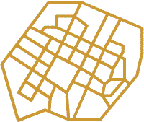
GPS-Trans Net-Cellphone Performances
GPS-Art is a new field of art activity based on motion in open spaces. GPS-Art is the global interactive instrument used for the creation and processing of audio and video material. It integrates elements of audio-visual installation to be used as a new media transmission. The project is based on large outdoor scales of cities and open spaces; it is ready to be realized on land, air, underwater as well as in outer space.
All GPS-Art projects use the GPS-12 device (Global Positioning System), as well as the cell phone system. GPS-12 refers to the 12 satellites hanging above the Northern half of the globe; it's used for navigation and measures in an interactive way many topographic parameters including latitude and speed. These measurments are the starting point of many art projects of GPS-Art. Since 2001 GPS-Art has been realized by a series of GPS-Trans net-cellphone performances.
Posted by jo at 05:13 PM | Comments (0)
March 29, 2005
DIALTONE

Teleinteractive Net Audio Experiment
DIALTONE is a net audio installation exposing the physical and virtual space of the internet and attempting to open this hybrid space for sounds, noises and words by using simple telecommunication instruments like telephones and answering machines. This audio interface between telephone network and internet explores how interaction and compression changes audio in a network. The installation connects the venue to our telecommunication network through sound and vision.
Posted by jo at 03:01 PM | Comments (0)
January 25, 2005
In Conversation
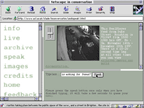
From Street to Chatroom
When live and located, In Conversation provided the means for individuals in the street and on the Internet to engage in a live dialogue with each other. This work by British artist Susan Collins aimed to examine the boundaries and social customs of distinctly different kinds of public spaces - the street and the Internet/chatroom-each with its own established rules of engagement.
Passers-by encountered an animated mouth projected onto the pavement and, through loudspeakers, could hear voices triggered by internet users trying to strike up a conversation. When the pedestrians responded, a concealed microphone and surveillance camera transmitted the responses to the website via a live video stream (webcast). Through the website, online visitors could view the surveillance video and hear the people on the street. They could type messages and send them 'live' to the installation where they were converted into speech and broadcast to the street through loudspeakers.
Posted by jo at 09:08 AM | Comments (0)
January 20, 2005
Tele-tap

Transparent Borders
"Where are the borders between public and private? Between art and life? Between urbanity and individual? - The project Tele-tap by the Amsterdam women artist group CUT-n-PASTE connected its listeners with a number of personalities active in Amsterdam's nightlife: a member of the Salvation Army, a harbour worker, a musician, a woman strolling through the pubs. Each of these personalities went into his urban environment, in his auditory-communicative hunting ground, lived there his life, played his role, provoked encounters. This was transmitted live by the permanent open mike of their mobile phones. Each of them could be wiretapped by the audience via radio, Internet or at the performance venue. Tele-tap showed how undefinable the borders can become between intimate and public space in a mobile communicating society. The technical »heart« of the project is the Internet, where the mobile phone sound inputs were converted into live audio streams and were audible all over the world. These streams also went on air as radio signals, and were accessible by headphones and loudspeakers at the performance venue itsself. The last time Tele-tap was live aired and live performed was on August 31 and September 1, 2001 on the Dutch radio channel VPRO and at »De Balie«, an Amsterdam cultural center. New technologically and dramaturgically extended versions of the project are in preparation. [via AudioHyperspace]
Posted by jo at 03:19 PM | Comments (0)
the Electronic Guy
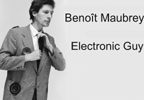
Performing Electro-Acoustic Clothes
Benoit Maubrey performs the Electronic Guy (guitar, sampler, electroacoustic Jacket, solar radio); Video In Studios, Vancouver February 14th, 8:00 PM; and Location 1, NYC, February 18th, 8:00 PM. Following the performance will be a video and slide presentation concerning Die Audio Gruppe.
Benoît Maubrey is the director of Die Audio Gruppe, a Berlin-based art group that builds electro-acoustic clothes and performs in them. Equipped with movement and light sensors, radio receivers, sound generators, samplers, amplifiers, loudspeakers - the clothes produce sounds by interacting with the environment and in response to the performers' movements (past examples: AUDIO BALLERINAS, AUDIO GEISHAS, AUDIO STEELWORKERS, BONG BOYS, AUDIO PEACOCKS...).
Stay tuned for Phonomaniacs (see web site): Maubrey's visit is the opening movement in a larger cooperative project between Die Audio Gruppe and local artists being planned for later this year. It will consist of a series of workshops followed by a sound event featuring 20-30 electro-acoustically costumed performers.
Posted by jo at 09:56 AM | Comments (0)
January 19, 2005
Transfers
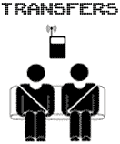
GPS+Video/Audio+You=Mobile Art
Transfers--by Matt Roberts--is a project exploring real-time generation of art and user participation in a mobile environment. Transfers allows a passenger of a taxi to generate a unique piece of art by giving the taxi driver directions. As the taxi moves through the city the passenger experiences a real-time manipulation of live exterior video and audio taken from a camera and microphone mounted in the taxi. The taxi is also equipped with a GPS that feeds an onboard computer data such as speed and direction. This computer is running custom audio/video manipulation software and uses GPS data to make decisions about how the live video/audio feed is manipulated and seen by the passenger. The manipulations of the live feed is displayed on two LCD screens and heard through the cars stereo system. As the user tells the driver where to go the passenger becomes both performer and viewer as they experience a unique piece of art generated by their decisions. The software also records this performance and at the end of the drive the passenger receives a CD with a QuickTime movie file of his or her recorded performance. [via Rhizome] Related >>
Posted by jo at 02:56 PM | Comments (0)
January 14, 2005
Permanent Creation
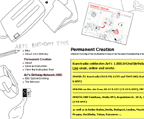
Art's Birthday 2005
This year's Art's Birthday celebrations in Vienna stand under the motto Permanent Creation and will - as in previous years - take place as a networked project with partner nodes around the world joining in and contributing to the broadcast special. For the first time, also the Ars Acustica group of the European Broadcasting Union (EBU) will participate in the Art's Birthday special and send acoustic contributions and sound samples serving also as source material for new pieces via satellite, thus expanding the global network by national broadcasting companies in Baden - Baden, Berlin, Madrid, Moscow, Oslo, Prag, Stockholm and Vienna.
In Vienna, the artist groups alien productions and IFTAF - Institute for Transacoustic Research will perform and jam with the partners of the network and will stage miniature performances due to instructions either submitted by the audience or from a collection of action instructions. For these performances, there will be a range of props available in the studio and each of the short acoustic actions will be performed within a fixed setting: a white table equipped with various (analogue) tools.
You can add your instruction for Permanent Creation to an on-line pool, which is the base material for the miniature performances. Furthermore, listeners of Kunstradio as well as artist collegues are invited to come to the studio and join in the action.
on air: OE1 Kunstradio (FM, SW, MW) - 21:00 - 23:00 GMT
on line: http://kunstradio.at
on site: Funkhaus, Studio 3, Argentinierstr. 30a, A - 1040 Vienna
The History of Art's Birthday
WIENCOUVER 2000
"In 1980, when the modern Fax machine was still an exotic promise and computers either massive mainframes or playthings for the hobbyist, artists in Vancouver and Vienna were collaborating on the first of the projects known as Wiencouver. WIENCOUVER 2000 is not a nostalgic look at the early years of Art+Telcomm but an exploration of the new technology available for artists working in the field as we approach the new millenium."
"Art's Birthday Party is a celebration in memory of Robert Filliou who declared, on January 17, 1963 that Art had been born exactly 1,000,000 years ago when someone dropped a dry sponge into a pail of water. 10 years later he celebrated Art's 1,000,010th birthday in the Neue Galerie, Aachen.
After Filliou's death in 1987 some artists began to celebrate Art's Birthday with mail-art, fax and slow scan tv events in the spirit of his concept of "The Eternal Network" or "La Fete permanente." The Birthday parties took place in different cities across the world and artists were asked to bring birthday presents for Art. -- works that could be shared over the network.
Art's Birthday Party has never been a formal event but was always organised on an ad hoc basis through the network. Every participating location (and they are different every year) organises its own party - from a few friends in a private studio to a performance evening in a museum, gallery or radio station . The only condition is that each group is able to send and receive birthday presents for Art. Since 1994 this has usually meant using the Internet in one form or other.
Filliou's invention of Art's Birthday is wonderfully absurd and humorous in the typical Fluxus tradition of serious fun. So the global birthday party for art has always tried to be fun while paying homage to Robert Filliou's dream of The Eternal Network." Robert Adrian 2004
Art's Birthday Network
EBU Ars Acustica Special Evening
Posted by jo at 12:26 PM | Comments (0)
January 12, 2005
HopStory
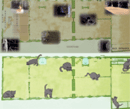
Interactive, Location-based Narrative Distributed in Space and Time
"As computing and communications technologies evolve, there is the potential for new forms of digitally orchestrated interactive narratives to emerge. In this process, balanced attention has to be paid to audience experience, creative constraints, and presence and role of the enabling technology. This paper describes the implementation of HopStory, an interactive, location-based narrative distributed in space and time, which was designed with this balance in mind. In HopStory, cinematic media is housed within wireless sculptures distributed throughout a building. The audience, through physical contact with a sculpture, collects scenes for later viewing. Inspired by the history of the installation space the narrative relates a day in the life of four characters. By binding the story to local time and space and inviting the audience to wander, we amplify the meaning and impact of the HopStory content and introduce an innovative approach to a day-in-the-life story structure." Abstract for Hopstory: an Interactive, Location-based Narrative Distributed in Space and Time by Valentina Nisi, Alison Wood, Glorianna Davenport and Ian Oakley [PDF]
Posted by jo at 02:57 PM | Comments (0)
January 04, 2005
Dry Translator
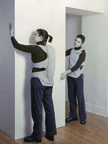
Walls as Touch Messaging Devices
Dry Translator, a sculptural installation piece by Sabrina Raaf, is built in response to new trends in 'smart architecture.' Smart technology is being created for enhanced human interaction and control of one’s urban building and home environments. Interestingly what excites many is not the necessarily the enhancement of control, but really more the idea of intelligent responsiveness and heightened personal connection with the rooms they inhabit.
Dry Translator is taking this idea of responsiveness to an exaggerated degree. The idea is to create an environment so sensitive to human presence that a touch to its walls sends resonant vibrations throughout the bodies of its occupants. Whereas normally people acknowledge the presence of walls in a building as merely types of boundaries or surfaces, this piece allows them to engage with walls in newly intimate ways such as touching, beating, and even 'playing' the walls as instruments. And, it also allows them to use the walls as sorts of touch messaging devices.
The piece includes two custom designed audio vests (which gallery visitors are invited to put on) and an interactive wall. Essentially what occurs with this piece is that when a participant touches the wall in the gallery, they hear the sound of their touch not locally where their fingers hit the wall, but actually on their own torso (via the vest). Inside of the wall there are several wired tentacles that act like stethoscopes which are able to pick up the slightest vibrations within the drywall material. Sounds from participants touching the wall are greatly amplified and transmitted wirelessly to the vests. The wall becomes a skin-like extension of the participant’s own body. In touching the wall, they touch their self. Participants may also record a series of touches or gestures on the wall via an interactive consol and thereby leave a message for the next participant to play back on the vest.
Posted by jo at 08:01 AM | Comments (0)
Saturday
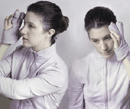
Sounds Mixed in the Bones of the Listener
"With the overuse of radio frequency bands for wireless communications, there comes the increased occurrence of crossed lines where a private conversation becomes accidentally shared. To create this interactive sound piece, Saturday, [Sabrina Raaf] used walkie talkies, CB radios, and various other forms of consumer spy (or ‘security’) technology in order to actively harvest such communication leaks. Saturday forms a uniquely intimate portrait of the community of Humboldt Park, Chicago through a composite presentation of conversations stolen on Saturdays in the park. Saturday is a sound based artwork that participants experience through a custom designed glove interface. [via near near future]
When I began working with wireless sound technology, I was startled by the sheer quantity of non-phone, low tech, radio transmissions that were constantly being sent around my neighborhood. Humboldt Park is a lower income, racially mixed neighborhood of Chicago. The transmissions included communications between gang members on street corners nearby and group conversations between friends talking about changes in the neighborhood and their families. There were raw, intimate conversations and often even late night sex talk between potential lovers. There is a furtive quality to most of these conversations and also a particular daringness in their tone. During the series of Saturdays, I also recorded the sounds of my neighborhood – the women singing out their windows to their radios, the young men in their low rider cars circling the block, the children, the ice cream carts, etc. These are the sounds that are mixed in the piece. And, these are the sounds that literally drip from participant’s fingertips in Saturday.
Saturday is presented in the form of an interactive glove. In order to hear the audio, participants magically just press their fingertips to their forehead and they hear the sound without the use of their ears. The glove is outfitted with leading edge audio electronic devices called “bone transducers” which make this possible. These transducers transmit sound in a very unusual fashion. They translate sound into vibration patterns which resonate through bone. This is the same process as the natural hammer and anvil system inside our inner ears which allows us to perceive sound. Since the bone transducer does all this work artificially, it allows you to hear crisp audio without it being played out loud or through headphones. So, even if a user covered their ears and then placed their fingers to their temples, they still ‘hear’ the sound. No sound at all is heard by anyone but the participant at any time. This piece permits a new way of listening. The user places their fingers to their forehead – in a gesture akin to Rodin’s The Thinker or of a clairvoyant – in order to tap into the lives of strangers. Pressing different combinations of fingers to the temple yield plural viewpoints and group conversations. These sounds are literally mixed in the bones of the listener."
Posted by jo at 07:50 AM | Comments (0)
January 03, 2005
Record_
![]()
Virtual-Sound-City
Record_ by Alberto Guedea: _pre-recorded audio from computer hardware manipulations [using hardware as musical instruments] processed and de-constructed live, digitally_"For this venue I will be studying the idea of a virtual-sound-city by recording audio pieces, utilizing computer hardware as the only physical 'musical instruments' to produce the recorded sound. These recordings of hardware manipulations will be processed afterwards through various popular music software engines in a series of long length private and public performances which will be webcast in real time, through the Reverie server during January 2005.
The webcast performances will be abstract net-installations of audio and they will be focused primarily on the concept idea rather than on schematic or structured musical compositions. These sound installations and audio investigations will address virtual reality in present times."
Posted by jo at 08:21 AM | Comments (0)
MuSE

Multiple Streaming Engine
MuSE provides the free software community with a user friendly but powerful tool for network audio streaming, making life easier for indypendent free speech online radios.
MuSE is an application for the mixing, encoding, and network streaming of sound: it can mix up to 6 encoded audio bitstreams (from files or network, mp3 or ogg) plus a souncard input signal, the resulting stream can be played locally on the sound card and/or encoded at different bitrates, recorded to harddisk and/or streamed to the net. When sent to a server, the resulting audio can be listened thru the net by a vast number of players available on different operating systems.
To be operated MuSE offers graphical interfaces and a documented commandline interface in the good old unix style. MuSE is free software and it is released open source under the terms of the GNU General Public License.
Posted by jo at 08:07 AM | Comments (0)
September 25, 2004
street stories

[murmur]
[murmur] is an archival audio project that collects and curates stories set in specific Toronto locations. At each of these locations, a [murmur] sign marks the availability of a story with a telephone number and location code. By using a mobile phone, users are able to listen to the story of that place while engaging in the experience of being there.
Toronto is a city of stories. But the rapid progress and growth that replaces its structures erases its stories as well. [murmur], conceived by Shawn Micallef, James Roussel and Gabe Sawhney, aims to keep these stories alive and on the streets. Their plan is to expand throughout Toronto, step by step, until a [murmur] sign is located everywhere a story the rest of us should hear exists.
For more, read the 8/19/04 Eye article Flaneur by Phone
Posted by newradio at 05:58 PM | Comments (0)
July 30, 2004
Networked Local Performances
Three Performances: 2001-03: A Comment
The three location-specific performances Dialtones: A Telesymphony, Flip Flop, and Texterritory --you had to be there to experience them--introduced in the last posts were produced between 2001 and 2003 They made use of networked technologies--mobile phones, video/audio relayed by wireless broadband--to involve their audiences in the creation of the performances. Each has done this successfully in its own way, while maintaining control, in the case of Dialtones, a tight control, over the performance itself.
Posted by newradio at 10:06 AM | Comments (0)

